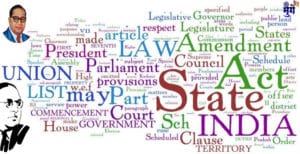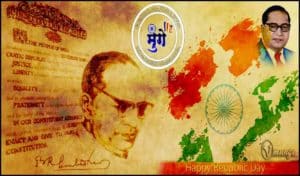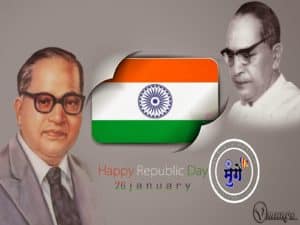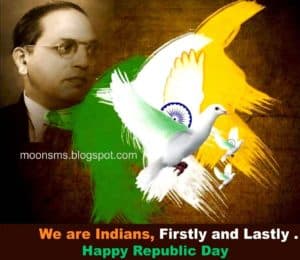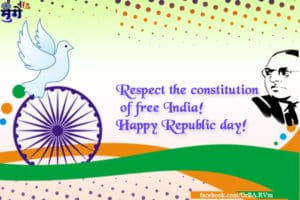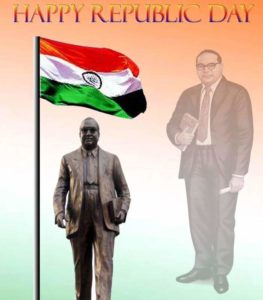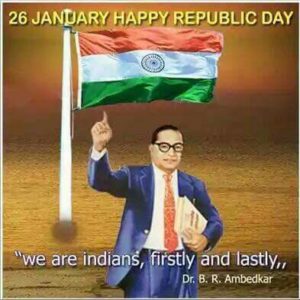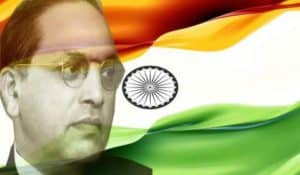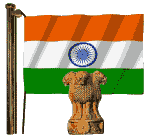2512 Thu 25 Jan 2018 LESSON
Unrevealed facts about Republic day in India

The ceremonial performance of bands of the defense forces was started
in the early 1950s by a certain Major Roberts of the Indian Army.
One of the most popular tune that is played at the Republic day
functions is ‘Abide with me’, a Christian hymn, which was said to be
Mahatma Gandhi’s favourite.
Republic Day celebration actually lasts for three days! The ‘Beating Retreat’ held on 29th January,
marks the end of all Republic day celebrations in the country. The
ceremony is held at Vijay Chowk where bands of the Indian Army, Indian
Air Force and Indian Navy perform.
There are just two original
copies of the Constitution in the country written in Hindi and English.
They have been preserved in helium-filled cases in the Parliament of
India. This constitution has been calligraphed and not printed. Such
photo lithographic copies are in circulation and only 1000 copies have
been written till date.
The President addresses the Republic Day whereas; the Prime Minister addresses the Independence Day.
Our Constitution is the longest in the world. You definitely cannot read it in a single day.
Now, writing the constitution was not simple. The Assembly gathered for
166 days that was spread over two years, 11 months and 18 days before
the final version was formed. Yes, it was all hand-written and it was on
the 26th of January that marked the celebration of Independence in its
true sense.
The Constitution came into a legal circulation at 10:18 AM on the 26th of January, 1950.
There are 12 Schedules and 395 Articles
Till 2006 there are 96 Amendments are made.|
http://www.legalservicesindia.com/…/dr-b-r-ambedkar-the-fat…
“The third thing we must do is not be content with mere political
democracy. We must note that our political democracy can not last unless
there lies at the base of it social democracy. What does social
democracy mean? It means a way of life which recognizes liberty,
equality and fraternity as the principles of life.” – Dr. B.R. Ambedkar
In the world the great man first has to be born in the form of the great man and
then he has to prove himself the great man by his enriched personality
with virtues and by his great capability. According to such a rule of
the world Dr. Bhimrao Ramji Ambedkar was born in the form of the great
man, on 14th April 1891 at Mahu in Madhya Pradesh of India. Bhimrao
Ramji Ambedkar, also known as Babasaheb, was an Indian nationalist,
jurist, Dalit, political leader, activist, philosopher, thinker,
anthropologist, historian, orator, profilic writer, economist, scholar,
editor, revolutionary and the revivalist of Buddhism in India. He was
also the chief architect of the Indian constitution. Born into a poor
untouchable family, Ambedkar spent his whole life fighting against
social discrimination, the system of Chaturvarna – the Hindu
categorization of human society into four varnas – and the Indian Caste
System.
The great man Dr.
Bhimrao Ramji Ambedkar’s active life, glorious personality and great
capability these characteristics forever are worthy of writing with the
golden letters, in the useful history of the nation India of the entire
world and of the universal mankind.
third thing we must do is not be content with mere political democracy.
We must note that our political democracy can not last unless there
lies at the base of it social democracy.
Malayalam Scraps
https://www.thatstamilnews.com/dr-ambedkar-biography-thats…/
Bhimrao Ramji Ambedkar Biography:
Personal details:
Born 14 April 1891
Mhow, Central Provinces, India (now in Madhya Pradesh)
Died 6 December 1956 (aged 65)
Delhi, India
Political party Samata Sainik Dal
Other political
affiliations Independent Labour Party, Scheduled Castes Federation
Spouse(s):
Ramabai (m. 1906; d. 1935)
Savita Ambedkar (m. 1948)
Alma mater: University of Mumbai, Columbia University
London School of Economics
Profession: Jurist, economist, politician, social reformer
Religion: Hinduism (1891–1956) and Buddhism (1956)
Awards: Bharat Ratna (posthumously in 1990)
Wish You A Very Happy Republic Day!
May You Be Ever Happy, Well and Secure!
May All Sentient and Non-sentient Beings in This Universe Be Ever Happy, Well and Secure!
May All Live Long!
May All Have Calm, Quiet, Alert, Attentive and An Equanimity Mind
With a Clear Understanding that Nothing is Permanent!
https://ta.wikipedia.org/…/%E0%AE%85%E0%AE%AE%E0%AF%8D%E0%A…
கட்டற்ற கலைக்களஞ்சியமான விக்கிப்பீடியாவில் இருந்து.
முனைவர்
பீம்ராவ் ராம்ஜி அம்பேத்கர்
Ambedkar speech at Yeola.png
13 அக்டோபர் 1935 அன்று நாசிக்கில் ஒரு பொதுக்கூட்டத்தில் உரையாற்றுகின்றார்
பிறப்பு பீமாராவ் சக்பால் அம்பேவாதேகர்
ஏப்ரல் 14, 1891
மாவ் (Mhow), பிரித்தானிய இந்தியா (இப்போது மத்தியப் பிரதேசம்)
இறப்பு 6 திசம்பர் 1956 (அகவை 65)
தில்லி, இந்தியா
தேசியம் இந்தியர்
மற்ற பெயர்கள் பாபா சாகேப், பாபா, பீமா, மூக்நாயக்
படித்த கல்வி நிறுவனங்கள் மும்பை பல்கலைக்கழகம்
கொலம்பியா பல்கலைக்கழகம்
இலண்டன் பல்கலைக்கழகம்
இலண்டன் பொருளாதாரப் பள்ளி
அமைப்பு(கள்) சுதந்திர தொழிலாளர் கட்சி, இந்தியக் குடியரசுக் கட்சி, பட்டியல் சாதிகள் கூட்டமைப்பு
பட்டம் முதல் இந்திய சட்ட அமைச்சர், இந்திய அரசியலமைப்பு வரைவு குழுவின் தலைவர்
அரசியல் இயக்கம் தலித் பௌத்த இயக்கம்
சமயம் பௌத்தம்
வாழ்க்கைத்
துணை இராமாபாய் அம்பேத்கர் (தி. 1906)[1]
சவிதா அம்பேத்கர் (தி. 1948)[2]
விருதுகள் பாரத ரத்னா
கையொப்பம்
பாபா சாகேப் என்றழைக்கப்படும் பீம்ராவ் ராம்ஜி அம்பேத்கர்
(ஆங்கிலம்:Bhimrao Ramji Ambedkar, பிறப்பு:14 ஏப்ரல் 1891 – 6 திசம்பர்
1956) இந்திய விடுதலைக்குப் பின்னர் நாட்டின் முதலாவது சட்ட அமைச்சராக
பதவியேற்றவர். உயர் கல்வி பெறுவதற்காக அமெரிக்கா சென்ற முதல் இந்தியர்
ஆவார்.
தாழ்த்தப்பட்ட மக்களுக்கென கழகம் ஒன்றைத் தொடங்கியவர். பரோடா
மன்னருடன் இணைந்து தீண்டாமை ஒழியப் போராடியவர். பொருளாதாரம், அரசியல்,
வரலாறு, தத்துவம், சட்டம் ஆகிய துறைகளில் தேர்ந்தவர்; ஆசிரியராகவும்,
இதழாளராகவும், எழுத்தாளராகவும் சமூகநீதிப் புரட்சியாளராகவும் விளங்கியவர்.
‘திராவிட புத்தம்’ என்ற பெயரில் பல ஆயிரக்கணக்கான தாழ்த்தப்பட்டவர்
எனப்பட்ட தலித் மக்களை புத்தசமயத்தைத் தழுவச்செய்தவர்; இவை யாவற்றுக்கும்
மேலாக இந்திய அரசியலமைப்புச் சாசனத்தை வரைவதற்கான குழுவின் தலைவராகவும்
பொறுப்பேற்றவர். 2012 ஆம் ஆண்டில் வரலாற்றுத் தொலைக்காட்சியும்,
சி.என்.என்- ஐ.பி.என் தொலைக்காட்சியும் நடத்திய வாக்கெடுப்பில் மிகச்சிறந்த
இந்தியராகத் தேர்ந்தெடுக்கப்பட்டார்.[3][4] இந்தியாவின் மிகச்சிறந்த உயரிய
விருதான ‘பாரத ரத்னா’ விருது இவரது இறப்புக்குப் பின் 1990 இல் இவருக்கு
வழங்கப்பட்டது.[5]
பொருளடக்கம்
1 வாழ்க்கை வரலாறு
1.1 இளமை
1.2 கல்வி
2 சமூகப்பணிகள்
3 தீண்டாமைக்கு எதிராக
3.1 புனே உடன்படிக்கை
4 அரசியல் வாழ்க்கை
5 இந்திய அரசியலமைப்பில் பங்கு
6 ரிசர்வ் வங்கி உருவாக்கத்தில் பங்கு
7 பௌத்த சமயத்திற்கு மாறுதல்
8 மரணம்
9 அம்பேத்கர் கருத்துக்கள்
10 ஆவணப்பதிவுகள்
11 கெளரவிப்புகள்
12 ஊடகங்கள்
13 மேற்கோள்கள்
14 வெளி இணைப்புகள்
15 மேலதிக வாசிப்பு
சாகேப் என்றழைக்கப்படும் பீம்ராவ் ராம்ஜி அம்பேத்கர் (Bhimrao Ramji
Ambedkar; 14 ஏப்ரல் 1891 – 6 திசம்பர் 1956) இந்திய விடுதலைக்கு……
https://tamil.oneindia.com/…/india-dr-br-ambedkar-the-great…
இந்தியாவின் மாபெரும் தலைவர் அண்ணல் அம்பேத்கர் - 2 கோடி பேர் வாக்களிப்பு!
டெல்லி: மகாத்மா காந்திக்குப் பின் சுதந்திர இந்தியாவின் மாபெரும் தலைவர்
யார் என்பது குறித்து மக்களிடம் நடத்திய வாக்கெடுப்பில், அண்ணல் டாக்டர்
அம்பேத்கர் முதலிடம் பெற்றுள்ளார். அவருக்கு 2 கோடி பேர் வாக்களித்து,
நாட்டின் ஒப்பற்ற தலைவர் என்று உறுதிப்படுத்தியுள்ளனர். ஆன்லைன், கள ஆய்வு
மற்றும் நடுவர் வாக்குகள் அடிப்படையில் இந்த தேர்வு நடத்தப்பட்டது.
இவற்றில் அண்ணல் அம்பேத்கருக்கு 2 கோடி வாக்குகள் கிடைத்தன. தேசத்தின்
ஒப்பற்ற தலைவர் அவரே என்பது பெருவாரியான மக்களால்
உறுதிப்படுத்தப்பட்டுள்ளது. டாக்டர் அம்பேத்கரை ஒரு தலித் சமுதாய தலைவராக,
பிரதிநிதியாகப் பார்க்கக் கூடாது என்றும், அவர் இந்த நாட்டைக் கட்டமைத்த
ஒப்பற்ற சிற்பி என்பதை ஒவ்வொரு இந்தியரும் மனதில் கொள்ள இது ஒரு வாய்ப்பு
என்றும் பெரும்பாலானோர் கருத்து தெரிவித்திருந்தனர். தேசத்தின் தந்தைக்கு
நிகரானவர், இந்திய அரசியல் சாசனத்தின் தந்தை என்றெல்லாம் அம்பேத்கருக்கு
புகழ் மாலை சூட்டியுள்ளனர் கருத்துக் கணிப்பில் பங்கேற்றவர்கள். இந்த
தேர்வில் முதல் பத்து இடங்களைப் பிடித்த தலைவர்கள் மற்றும் பிற
துறையினர்… 1. பாபாசாகேப் டாக்டர் பிஆர் அம்பேத்கர் 2. டாக்டர்
அப்துல்கலாம் 3.வல்லபபாய் படேல் 4.ஜவஹர்லால் நேரு 5.அன்னை தெரசா 6.ஜேஆர்டி
டாடா 7.இந்திரா காந்தி 8.சச்சின் டெண்டுல்கர் 9. அடல் பிகாரி வாஜ்பாய் 10.
லதா மங்கேஷ்கர்
for the Greatest Indian after Mahatma Gandhi is over. BR Ambedkar, the
Father of Indian Constitution, is the overwhelming choice.
Ramji Ambedkar Biography: Personal details: Born 14 April 1891 Mhow,
Central Provinces, India (now in Madhya Pradesh) Died 6 December 1956
(aged 65) Delhi, India Political party Samata Sainik Dal Other political
affiliations Independent…
Dr. Babasaheb Ambedkar Movie in Tamil - pinterest.com
Tamil Kavithai & Tamil Quotes - Pinterest
https://hi.m.wikipedia.org/…/%E0%A4%AC%E0%A5%80_%E0%A4%86%E…
बी आर अम्बेडकर
पेज समस्याएं
भारतीय राजनीतिक एवं समाज सुधारक
भीमराव रामजी आंबेडकर ( १४ अप्रैल, १८९१ – ६ दिसंबर, १९५६ )बाबा साहेब के
नाम से लोकप्रिय , भारतीय विधिवेत्ता ,अर्थशास्त्री ,राजनीतिज्ञ और
समाजसुधारक थे।[1] उन्होंने दलित बौद्ध आंदोलन को प्रेरित किया और दलितों
के खिलाफ सामाजिक भेद भाव के विरुद्ध अभियान चलाया। श्रमिकों और महिलाओं के
अधिकारों का समर्थन किया।[2] वे स्वतंत्र भारत के प्रथम कानून मंत्री एवं
भारतीय संविधान के प्रमुख वास्तुकार थे।[3][4][5][6] आंबेडकर विपुल प्रतिभा
का छात्र थे। उन्होंने कोलंबिया विश्वविद्यालय और लन्दन स्कूल ऑफ़
इकोनॉमिक्स दोनों ही विश्वविद्यालयों से अर्थशास्त्र में डॉक्टरेट की उपाधि
प्राप्त की। उन्होंने विधि ,अर्थशास्त्र और राजनीति विज्ञानं के शोध कार्य
में ख्याति प्राप्त की [7]जीवन के प्रारम्भिक करियर में वह अर्थशास्त्र के
प्रोफेसर रहे एवम वकालत की। बाद का जीवन राजनीतिक गतिविधियों में बीता।
1956 में उन्होंने बौद्ध धर्म अपना लिया। 1990 में, भारत रत्न, भारत के
सर्वोच्च नागरिक सम्मान मरणोपरांत अम्बेडकर पर सम्मानित किया गया था।
प्रारंभिक जीवन
आंबेडकर का जन्म ब्रिटिश भारत के मध्य भारत प्रांत (अब मध्य प्रदेश में)
में स्थित नगर सैन्य छावनी महू में हुआ था।[8] वे रामजी मालोजी सकपाल और
भीमाबाई की १४ वीं व अंतिम संतान थे।[9] उनका परिवार मराठी था और वो आंबडवे
गांव जो आधुनिक महाराष्ट्र के रत्नागिरी जिले में है, से संबंधित था।[10]
वे हिंदू महार जाति से संबंध रखते थे, जो अछूत कहे जाते थे और उनके साथ
सामाजिक और आर्थिक रूप से गहरा भेदभाव किया जाता था। डॉ॰ भीमराव आंबेडकर के
पूर्वज लंबे समय तक ब्रिटिश ईस्ट इंडिया कंपनी की सेना में कार्यरत थे और
उनके पिता, भारतीय सेना की मऊ छावनी में सेवा में थे और यहां काम करते हुये
वो सूबेदार के पद तक पहुँचे थे। उन्होंने मराठी और अंग्रेजी में औपचारिक
शिक्षा की डिग्री प्राप्त की थी।
आंबेडकर को गौतम बुद्ध की शिक्षाओं
ने प्रभावित किया था। अपनी जाति के कारण उन्हें इसके लिये सामाजिक
प्रतिरोध का सामना करना पड़ रहा था। स्कूली पढ़ाई में सक्षम होने के बावजूद
छत्र भीमराव को अस्पृश्यता के कारण अनेका प्रकार की कठनाइयों का सामना
करना पड़ रहा था। रामजी सकपाल ने स्कूल में अपने बेटे भीमराव का उपनाम
‘सकपाल’ की बजायं ‘आंबडवेकर’ लिखवाया, क्योंकी कोकण प्रांत में लोग अपना
उपनाम गांव के नाम से लगा देते थे, इसलिए भीमराव का मूल अंबाडवे गांव से
अंबावडेकर उपनाम स्कूल में दर्ज किया। बाद में एक देशस्त ब्राह्मण शिक्षक
कृष्णा महादेव आंबेडकर जो उनसे विशेष स्नेह रखते थे, ने उनके नाम से
‘अंबाडवेकर’ हटाकर अपना सरल ‘आंबेडकर’ उपनाम जोड़ दिया। आज आंबेडकर नाम से
जाने जाते है।
आंबेडकर ने सन १८९८ मे पुनर्विवाह कर लिया और परिवार
के साथ मुंबई (तब बंबई) चले आये। यहाँ अम्बेडकर एल्फिंस्टोन रोड पर स्थित
गवर्न्मेंट हाई स्कूल के पहले अछूत छात्र बने।[11]
उच्च शिक्षा
गायकवाड शासक ने सन १९१३ में संयुक्त राज्य अमेरिका के कोलंबिया
विश्वविद्यालय मे जाकर अध्ययन के लिये भीमराव आंबेडकर का चयन किया गया साथ
ही इसके लिये एक ११.५ डॉलर प्रति मास की छात्रवृत्ति भी प्रदान की।
न्यूयॉर्क शहर में आने के बाद, डॉ॰ भीमराव आंबेडकर को राजनीति विज्ञान
विभाग के स्नातक अध्ययन कार्यक्रम में प्रवेश दे दिया गया। शयनशाला मे कुछ
दिन रहने के बाद, वे भारतीय छात्रों द्वारा चलाये जा रहे एक आवास क्लब मे
रहने चले गए और उन्होने अपने एक पारसी मित्र नवल भातेना के साथ एक कमरा ले
लिया। १९१६ में, उन्हे उनके एक शोध के लिए पीएच.डी. से सम्मानित किया गया।
इस शोध को अंततः उन्होंने पुस्तक इवोल्युशन ओफ प्रोविन्शिअल फिनान्स इन
ब्रिटिश इंडिया के रूप में प्रकाशित किया। हालाँकि उनकी पहला प्रकाशित काम,
एक लेख जिसका शीर्षक, भारत में जाति : उनकी प्रणाली, उत्पत्ति और विकास
है। अपनी डाक्टरेट की डिग्री लेकर सन १९१६ में डॉ॰ आंबेडकर लंदन चले गये
जहाँ उन्होने ग्रेज् इन और लंदन स्कूल ऑफ इकॉनॉमिक्स में कानून का अध्ययन
और अर्थशास्त्र में डॉक्टरेट शोध की तैयारी के लिये अपना नाम लिखवा लिया।
अगले वर्ष छात्रवृत्ति की समाप्ति के चलते मजबूरन उन्हें अपना अध्ययन
अस्थायी तौर बीच मे ही छोड़ कर भारत वापस लौटना पडा़ ये प्रथम विश्व युद्ध
का काल था। बड़ौदा राज्य के सेना सचिव के रूप में काम करते हुये अपने जीवन
मे अचानक फिर से आये भेदभाव से डॉ॰ भीमराव आंबेडकर निराश हो गये और अपनी
नौकरी छोड़ एक निजी ट्यूटर और लेखाकार के रूप में काम करने लगे। यहाँ तक कि
अपनी परामर्श व्यवसाय भी आरंभ किया जो उनकी सामाजिक स्थिति के कारण विफल
रहा। अपने एक अंग्रेज जानकार मुंबई के पूर्व राज्यपाल लॉर्ड सिडनेम, के
कारण उन्हें मुंबई के सिडनेम कॉलेज ऑफ कॉमर्स एंड इकोनोमिक्स मे राजनीतिक
अर्थव्यवस्था के प्रोफेसर के रूप में नौकरी मिल गयी। १९२० में कोल्हापुर के
महाराजा, अपने पारसी मित्र के सहयोग और अपनी बचत के कारण वो एक बार फिर से
इंग्लैंड वापस जाने में सक्षम हो गये। १९२३ में उन्होंने अपना शोध
प्रोब्लेम्स ऑफ द रुपी (रुपये की समस्यायें) पूरा कर लिया। उन्हें लंदन
विश्वविद्यालय द्वारा “डॉक्टर ऑफ साईंस” की उपाधि प्रदान की गयी। और उनकी
कानून का अध्ययन पूरा होने के, साथ ही साथ उन्हें ब्रिटिश बार मे बैरिस्टर
के रूप में प्रवेश मिल गया। भारत वापस लौटते हुये डॉ॰ भीमराव आंबेडकर तीन
महीने जर्मनी में रुके, जहाँ उन्होने अपना अर्थशास्त्र का अध्ययन, बॉन
विश्वविद्यालय में जारी रखा। उन्हें औपचारिक रूप से ८ जून १९२७ को कोलंबिया
विश्वविद्यालय द्वारा पीएच.डी. प्रदान की गयी।
छुआछूत के विरुद्ध संघर्ष
भारत सरकार अधिनियम १९१९, तैयार कर रही साउथबोरोह समिति के समक्ष, भारत के
एक प्रमुख विद्वान के तौर पर अम्बेडकर को गवाही देने के लिये आमंत्रित
किया गया। इस सुनवाई के दौरान, अम्बेडकर ने दलितों और अन्य धार्मिक
समुदायों के लिये पृथक निर्वाचिका (separate electorates) और आरक्षण देने
की वकालत की। १९२० में, बंबई से , उन्होंने साप्ताहिक मूकनायक के प्रकाशन
की शुरूआत की। यह प्रकाशन जल्द ही पाठकों मे लोकप्रिय हो गया, तब अम्बेडकर
ने इसका इस्तेमाल रूढ़िवादी हिंदू राजनेताओं व जातीय भेदभाव से लड़ने के
प्रति भारतीय राजनैतिक समुदाय की अनिच्छा की आलोचना करने के लिये किया।
उनके दलित वर्ग के एक सम्मेलन के दौरान दिये गये भाषण ने कोल्हापुर राज्य
के स्थानीय शासक शाहू चतुर्थ को बहुत प्रभावित किया, जिनका अम्बेडकर के साथ
भोजन करना रूढ़िवादी समाज मे हलचल मचा गया। अम्बेडकर ने अपनी वकालत अच्छी
तरह जमा ली और बहिष्कृत हितकारिणी सभा की स्थापना भी की जिसका उद्देश्य
दलित वर्गों में शिक्षा का प्रसार और उनके सामाजिक आर्थिक उत्थान के लिये
काम करना था। सन् १९२६ में, वो बंबई विधान परिषद के एक मनोनीत सदस्य बन
गये। सन १९२७ में डॉ॰ अम्बेडकर ने छुआछूत के खिलाफ एक व्यापक आंदोलन शुरू
करने का फैसला किया। उन्होंने सार्वजनिक आंदोलनों और जुलूसों के द्वारा,
पेयजल के सार्वजनिक संसाधन समाज के सभी लोगों के लिये खुलवाने के साथ ही
उन्होनें अछूतों को भी हिंदू मंदिरों में प्रवेश करने का अधिकार दिलाने के
लिये भी संघर्ष किया। उन्होंने महड में अस्पृश्य समुदाय को भी शहर की पानी
की मुख्य टंकी से पानी लेने का अधिकार दिलाने कि लिये सत्याग्रह चलाया।
१ जनवरी १९२७ को अम्बेडकर ने द्वितीय आंग्ल - मराठा युद्ध, की कोरेगाँव की
लडा़ई के दौरान मारे गये भारतीय सैनिकों के सम्मान में कोरेगाँव विजय
स्मारक मे एक समारोह आयोजित किया। यहाँ महार समुदाय से संबंधित सैनिकों के
नाम संगमरमर के एक शिलालेख पर खुदवाये। १९२७ में, उन्होंने अपना दूसरी
पत्रिका बहिष्कृत भारत शुरू की और उसके बाद रीक्रिश्टेन्ड जनता की। उन्हें
बाँबे प्रेसीडेंसी समिति मे सभी यूरोपीय सदस्यों वाले साइमन कमीशन १९२८ में
काम करने के लिए नियुक्त किया गया। इस आयोग के विरोध मे भारत भर में विरोध
प्रदर्शन हुये और जबकि इसकी रिपोर्ट को ज्यादातर भारतीयों द्वारा नजरअंदाज
कर दिया गया, डॉ अम्बेडकर ने अलग से भविष्य के संवैधानिक सुधारों के लिये
सिफारिशों लिखीं।
1927 तक, अम्बेडकर ने अस्पृश्यता के खिलाफ सक्रिय
आंदोलन शुरू करने का फैसला किया था। उन्होंने सार्वजनिक पेय जल संसाधनों को
खोलने के लिए सार्वजनिक आंदोलनों और मार्च के साथ शुरू किया। उन्होंने
हिंदू मंदिरों में प्रवेश करने के अधिकार के लिए एक संघर्ष भी शुरू किया।
उन्होंने अस्पृश्य समुदाय के अधिकार के लिए शहर के मुख्य जल टैंक से पानी
निकालने के लिए लड़ने के लिए महाड में एक सत्याग्रह का नेतृत्व किया। 1927
के अंत में सम्मेलन में, अम्बेडकर ने जाति भेदभाव और “अस्पृश्यता” को
वैचारिक रूप से न्यायसंगत बनाने के लिए क्लासिक हिंदू पाठ, मनुस्मृति (मनु
के कानून) की सार्वजनिक रूप से निंदा की, और उन्होंने औपचारिक रूप से
प्राचीन पाठ की प्रतियां जला दीं।[12] 25 दिसंबर 1927 को, उन्होंने हजारों
अनुयायियों का नेतृत्व मनुस्मृति की प्रतियां जलाया।[13] इस प्रकार
प्रतिवर्ष 25 दिसंबर को मनुस्मृति दहन दीन (मनुस्मृति बर्निंग डे) के रूप
में अम्बेडकरियों और दलितों द्वारा मनाया जाता है।
पूना संधि
राजनीतिक जीवन
अब तक अम्बेडकर आज तक की सबसे बडी़ अछूत राजनीतिक हस्ती बन चुके थे।
उन्होंने मुख्यधारा के महत्वपूर्ण राजनीतिक दलों की जाति व्यवस्था के
उन्मूलन के प्रति उनकी कथित उदासीनता की कटु आलोचना की। डॉ॰ भीमराव आंबेडकर
जी ने भारतीय राष्ट्रीय कांग्रेस और उसके नेता मोहनदास करमचंद गांधी की
आलोचना की, उन्होने उन पर अस्पृश्य समुदाय को एक करुणा की वस्तु के रूप मे
प्रस्तुत करने का आरोप लगाया। डॉ॰ आंबेडकर ब्रिटिश शासन की विफलताओं से भी
असंतुष्ट थे, उन्होने अस्पृश्य समुदाय के लिये एक ऐसी अलग राजनैतिक पहचान
की वकालत की जिसमे कांग्रेस और ब्रिटिश दोनों का ही कोई दखल ना हो। 8
अगस्त, 1930 को एक शोषित वर्ग के सम्मेलन के दौरान डॉ॰ आंबेडकर ने अपनी
राजनीतिक दृष्टि को दुनिया के सामने रखा, जिसके अनुसार शोषित वर्ग की
सुरक्षा उसके सरकार और कांग्रेस दोनों से स्वतंत्र होने में है।
हमें अपना रास्ता स्वयँ बनाना होगा और स्वयँ… राजनीतिक शक्ति शोषितो की
समस्याओं का निवारण नहीं हो सकती, उनका उद्धार समाज मे उनका उचित स्थान
पाने मे निहित है। उनको अपना रहने का बुरा तरीका बदलना होगा…. उनको
शिक्षित होना चाहिए… एक बड़ी आवश्यकता उनकी हीनता की भावना को झकझोरने और
उनके अंदर उस दैवीय असंतोष की स्थापना करने की है जो सभी उँचाइयों का
स्रोत है।[9]
इस भाषण में अम्बेडकर ने कांग्रेस और मोहनदास गांधी
द्वारा चलाये गये नमक सत्याग्रह की शुरूआत की आलोचना की। अम्बेडकर की
आलोचनाओं और उनके राजनीतिक काम ने उसको रूढ़िवादी हिंदुओं के साथ ही
कांग्रेस के कई नेताओं मे भी बहुत अलोकप्रिय बना दिया, यह वही नेता थे जो
पहले छुआछूत की निंदा करते थे और इसके उन्मूलन के लिये जिन्होने देश भर में
काम किया था। इसका मुख्य कारण था कि ये “उदार” राजनेता आमतौर पर अछूतों को
पूर्ण समानता देने का मुद्दा पूरी तरह नहीं उठाते थे। डॉ॰ भीमराव आंबेडकर
की अस्पृश्य समुदाय मे बढ़ती लोकप्रियता और जन समर्थन के चलते उनको १९३१ मे
लंदन में दूसरे गोलमेज सम्मेलन में, भाग लेने के लिए आमंत्रित किया
गया।(डा॰ भीमराव अंबेडकर ने तीनों गोलमेज सम्मेलनों में भाग लिया था ) उनकी
अछूतों को पृथक निर्वाचिका देने के मुद्दे पर तीखी बहस हुई। धर्म और जाति
के आधार पर पृथक निर्वाचिका देने के प्रबल विरोधी गांधी ने आशंका जताई, कि
अछूतों को दी गयी पृथक निर्वाचिका, हिंदू समाज की भावी पीढी़ को हमेशा के
लिये विभाजित कर देगी। गांधी को लगता था की, सवर्णों को अस्पृश्यता भूलाने
के लिए कुछ अवधि दी जानी चाहिए, यह गांधी का तर्क गलत सिद्ध हुआ जब सवर्णों
हिंदूओं द्वारा पूना संधि के कई दशकों बाद भी अस्पृश्यता का नियमित पालन
होता रहा।
१९३२ में जब ब्रिटिशों ने अम्बेडकर के साथ सहमति व्यक्त
करते हुये अछूतों को पृथक निर्वाचिका देने की घोषणा की,[14][15] तब मोहनदास
गांधी ने इसके विरोध मे पुणे की यरवदा सेंट्रल जेल में आमरण अनशन शुरु कर
दिया। मोहनदास गांधी ने रूढ़िवादी हिंदू समाज से सामाजिक भेदभाव और
अस्पृश्यता को खत्म करने तथा हिंदुओं की राजनीतिक और सामाजिक एकता की बात
की। गांधी के दलिताधिकार विरोधी अनशन को देश भर की जनता से घोर समर्थन मिला
और रूढ़िवादी हिंदू नेताओं, कांग्रेस के नेताओं और कार्यकर्ताओं जैसे
पवलंकर बालू और मदन मोहन मालवीय नेअम्बेडकर और उनके समर्थकों के साथ यरवदा
मे संयुक्त बैठकें कीं। अनशन के कारण गांधी की मृत्यु होने की स्थिति मे,
होने वाले सामाजिक प्रतिशोध के कारण होने वाली अछूतों की हत्याओं के डर से
और गाँधी के समर्थकों के भारी दवाब के चलते डॉ॰ भीमराव अंबेडकर जी ने अपनी
पृथक निर्वाचिका की माँग वापस ले ली। मोहनदास गांधी ने अपने गलत तर्क एवं
गलत मत से संपूर्ण अछूतों के सभी प्रमुख अधिकारों पर पानी फेर दिया। इसके
एवज मे अछूतों को सीटों के आरक्षण, मंदिरों में प्रवेश/पूजा के अधिकार एवं
छूआ-छूत ख़तम करने की बात स्वीकार कर ली गयी। गाँधी ने इस उम्मीद पर की
बाकि सभी सवर्ण भी पूना संधि का आदर कर, सभी शर्ते मान लेंगे अपना अनशन
समाप्त कर दिया।
आरक्षण प्रणाली में पहले दलित अपने लिए संभावित
उम्मीदवारों में से चुनाव द्वारा (केवल दलित) चार संभावित उम्मीदवार चुनते।
इन चार उम्मीदवारों में से फिर संयुक्त निर्वाचन चुनाव (सभी धर्म \ जाति)
द्वारा एक नेता चुना जाता। इस आधार पर सिर्फ एक बार सन १९३७ में चुनाव हुए।
डॉ॰ आंबेडकर २०-२५ साल के लिये राजनैतिक आरक्षण चाहते थे लेकिन गाँधी के
अड़े रहने के कारण यह आरक्षण मात्र ५ साल के लिए ही लागू हुआ। पूना संधी के
बारें गांधीवादी इतिहासकार ‘अहिंसा की विजय’ लिखते हैं, परंतु यहाँ अहिंसा
तो डॉ॰ भीमराव आंबेडकर ने निभाई हैं।
पृथक निर्वाचिका में दलित दो
वोट देता एक सामान्य वर्ग के उम्मीदवार को ओर दूसरा दलित (पृथक) उम्मीदवार
को। ऐसी स्थिति में दलितों द्वारा चुना गया दलित उम्मीदवार दलितों की
समस्या को अच्छी तरह से तो रख सकता था किन्तु गैर उम्मीदवार के लिए यह
जरूरी नहीं था कि उनकी समस्याओं के समाधान का प्रयास भी करता। बाद मे
अम्बेडकर ने गाँधी जी की आलोचना करते हुये उनके इस अनशन को अछूतों को उनके
राजनीतिक अधिकारों से वंचित करने और उन्हें उनकी माँग से पीछे हटने के लिये
दवाब डालने के लिये गांधी द्वारा खेला गया एक नाटक करार दिया। उनके अनुसार
असली महात्मा तो ज्योतीराव फुले थे।
राजनीतिक जीवन
संविधान निर्माण
धर्म परिवर्तन (बौद्ध धर्म में )
सन् 1950 के दशक में भीमराव अम्बेडकर बौद्ध धर्म के प्रति आकर्षित हुए और
बौद्ध भिक्षुओं व विद्वानों के एक सम्मेलन में भाग लेने के लिए श्रीलंका
(तब सीलोन) गये। पुणे के पास एक नया बौद्ध विहार को समर्पित करते हुए, डॉ॰
अम्बेडकर ने घोषणा की कि वे बौद्ध धर्म पर एक पुस्तक लिख रहे हैं और जैसे
ही यह समाप्त होगी वो औपचारिक रूप से बौद्ध धर्म अपना लेंगे।[22] 1954 में
अम्बेडकर ने म्यानमार का दो बार दौरा किया; दूसरी बार वो रंगून मे तीसरे
विश्व बौद्ध फैलोशिप के सम्मेलन में भाग लेने के लिए गये। 1955 में उन्होने
‘भारतीय बौद्ध महासभा’ या ‘बुद्धिस्ट सोसाइटी ऑफ इंडिया’ की स्थापना की।
उन्होंने अपने अंतिम महान ग्रंथ, ‘द बुद्ध एंड हिज़ धम्म’ को 1956 में पूरा
किया। यह उनकी मृत्यु के पश्चात सन 1957 में प्रकाशित हुआ। 14 अक्टूबर
1956 को नागपुर में डॉ॰ भीमराव अम्बेडकर ने खुद और उनके समर्थकों के लिए एक
औपचारिक सार्वजनिक समारोह का आयोजन किया। डॉ॰ अम्बेडकर ने श्रीलंका के एक
महान बौद्ध भिक्षु महत्थवीर चंद्रमणी से पारंपरिक तरीके से त्रिरत्न ग्रहण
और पंचशील को अपनाते हुये बौद्ध धर्म ग्रहण किया। इसके बाद उन्होने एक
अनुमान के अनुसार पहले दिन लगभग 5,00,000 समर्थको को बौद्ध धर्म मे
परिवर्तित किया।[22] नवयान लेकर अम्बेडकर और उनके समर्थकों ने विषमतावादी
हिन्दू धर्म और हिन्दू दर्शन की स्पष्ट निंदा की और उसे त्याग दिया।[कृपया
उद्धरण जोड़ें] भीमराव ने दुसरे दिन 15 अक्टूबर को नागपूर में अपने
2,00,000 अनुयायीओं को बौद्ध धम्म की दीक्षा दी, फिर तिसरे दिन 16 अक्टूबर
को भीमराव चंद्रपुर गये और वहां भी उन्होंने 3,00,000 समर्थकों को बौद्ध
धम्म की दीक्षा दी। इस तरह केवल तीन में भीमराव ने 10 लाख से अधिक लोगों को
बौद्ध धर्म में परिवर्तित किया। अम्बेडकर का बौद्ध धर्म परिवर्तन किया। इस
घटना से बौद्ध देशों में से अभिनंदन प्राप्त हुए। में इसके बाद वे नेपाल
में चौथे विश्व बौद्ध सम्मेलन मे भाग लेने के लिए काठमांडू गये। उन्होंने
अपनी अंतिम पांडुलिपि बुद्ध या कार्ल मार्क्स को 2 दिसंबर 1956 को पूरा
किया।
अम्बेडकर ने दीक्षाभूमि, नागपुर, भारत में ऐतिहासिक बौद्ध
धर्मं में परिवर्तन के अवसर पर,14 अक्टूबर 1956 को अपने अनुयायियों के लिए
22 प्रतिज्ञाएँ निर्धारित कीं जो बौद्ध धर्म का एक सार या दर्शन है। डॉ॰
भीमराव आंबेडकर द्वारा 10,00,000 लोगों का बौद्ध धर्म में रूपांतरण
ऐतिहासिक था क्योंकि यह विश्व का सबसे बड़ा धार्मिक रूपांतरण था। उन्होंने
इन शपथों को निर्धारित किया ताकि हिंदू धर्म के बंधनों को पूरी तरह पृथक
किया जा सके। भीमराव की ये 22 प्रतिज्ञाएँ हिंदू मान्यताओं और पद्धतियों की
जड़ों पर गहरा आघात करती हैं। ये एक सेतु के रूप में बौद्ध धर्मं की
हिन्दू धर्म में व्याप्त भ्रम और विरोधाभासों से रक्षा करने में सहायक हो
सकती हैं। इन प्रतिज्ञाओं से हिन्दू धर्म, जिसमें केवल हिंदुओं की ऊंची
जातियों के संवर्धन के लिए मार्ग प्रशस्त किया गया, में व्याप्त
अंधविश्वासों, व्यर्थ और अर्थहीन रस्मों, से धर्मान्तरित होते समय स्वतंत्र
रहा जा सकता है। ये प्रतिज्ञाए बौद्ध धर्म का एक अंग है जिसमें पंचशील,
मध्यममार्ग, अनिरीश्वरवाद, दस पारमिता, बुद्ध-धम्म-संघ ये त्रिरत्न,
प्रज्ञा-शील-करूणा-समता आदी बौद्ध तत्व, मानवी मुल्य (मानवता) एवं
विज्ञानवाद है।
मृत्यु
बाबा साहेब का देहांत ६ दिसंबर १९५६ को
दिल्ली स्थित उनके निवास पर हुआ। भारत सरकार के पास संविधान निर्माता
डॉक्टर भीमराव आंबेडकर की मौत से जुड़ी कोई जानकारी नहीं है। सुनने में यह
भले ही अटपटा लगे, लेकिन RTI के ज़रिए मांगी गई जानकारी में केंद्र सरकार
ने यही जवाब दिया हैं| 1948 से, अम्बेडकर मधुमेह से पीड़ित थे। जून से
अक्टूबर 1954 तक वो बहुत बीमार रहे इस दौरान वो कमजोर होती दृष्टि से
ग्रस्त थे। राजनीतिक मुद्दों से परेशान अम्बेडकर का स्वास्थ्य बद से बदतर
होता चला गया और 1955 के दौरान किये गये लगातार काम ने उन्हें तोड़ कर रख
दिया। अपनी अंतिम पांडुलिपि “बुद्ध और उनके धम्म” को पूरा करने के तीन दिन
के बाद 6 दिसम्बर 1956 को अम्बेडकर का महापरिनिर्वाण नींद में दिल्ली में
उनके घर मे हो गया। 7 दिसंबर को मुंबई में दादर चौपाटी समुद्र तट पर बौद्ध
शैली मे अंतिम संस्कार किया गया जिसमें उनके लाखों समर्थकों, कार्यकर्ताओं
और प्रशंसकों ने भाग लिया। RTI ऐक्ट के तहत दायर आवेदन के जवाब में केंद्र
के दो मंत्रालयों और आंबेडकर प्रतिष्ठान ने अपने पास आंबेडकर की मौत से
जुड़ी कोई भी जानकारी होने से इनकार किया है। एक मंत्रालय के जन सूचना
अधिकारी ने यह भी कहा है कि उन्हें इस बात की जानकारी नहीं है कि मांगी गई
सूचना किस विभाग से संबद्ध है।
आरटीआई कार्यकर्ता आर एच बंसल ने
राष्ट्रपति सचिवालय में आवेदन दायर कर पूछा था कि डॉ. भीमराव आंबेडकर की
मौत कैसे और किस स्थान पर हुई थी? उन्होंने यह भी पूछा था कि क्या मृत्यु
उपरांत उनका पोस्टमॉर्टम कराया गया था। पोस्टमॉर्टम की स्थिति में उन्होंने
रिपोर्ट की एक प्रति मांगी थी।
आवेदन में यह भी पूछा गया था कि
संविधान निर्माता की मृत्यु प्राकृतिक थी या फिर हत्या? उनकी मौत किस तारीख
को हुई थी, क्या किसी आयोग या समिति ने उनकी मौत की जांच की थी?
राष्ट्रपति सचिवालय ने यह आवेदन गृह मंत्रालय के पास भेज दिया जिस पर गृह
मंत्रालय द्वारा आवेदक को दी गई सूचना में कहा गया है कि डॉ. अंबेडकर की
मृत्यु और संबंधित पहलुओं के बारे में मांगी गई जानकारी मंत्रालय के किसी
भी विभाग, प्रभाग और इकाई में उपलब्ध नहीं है ।
मृत्युपरांत
अम्बेडकर के परिवार में उनकी दूसरी पत्नी सविता अम्बेडकर रह गयी थीं जो,
जन्म से ब्राह्मण थीं पर उनके साथ ही वो भी धर्म परिवर्तित कर बौद्ध बन गयी
थीं, तथा दलित बौद्ध आंदोलन में भाग लेती थी। विवाह से पहले उनकी पत्नी का
नाम डॉ॰ शारदा कबीर था। डॉ॰ सविता अम्बेडकर की एक बौद्ध के रूप में सन्
2002 में मृत्यु हो गई, अम्बेडकर के पौत्र, प्रकाश यशवंत अम्बेडकर, भारिपा
बहुजन महासंघ का नेतृत्व करते है और भारतीय संसद के दोनों सदनों के सदस्य
रह चुके है। कई अधूरे टंकलिपित और हस्तलिखित मसौदे अम्बेडकर के नोट और
पत्रों में पाए गए हैं। इनमें वैटिंग फ़ोर ए वीसा जो संभवतः 1935-36 के बीच
का आत्मकथानात्मक काम है और अनटचेबल, ऑर द चिल्ड्रन ऑफ इंडियाज़ घेट्टो जो
1951 की जनगणना से संबंधित है। एक स्मारक अम्बेडकर के दिल्ली स्थित उनके
घर 26 अलीपुर रोड में स्थापित किया गया है। अम्बेडकर जयंती पर सार्वजनिक
अवकाश रखा जाता है। 1990 में उन्हें मरणोपरांत भारत के सर्वोच्च नागरिक
सम्मान भारत रत्न से सम्मानित किया गया है। कई सार्वजनिक संस्थान का नाम
उनके सम्मान में उनके नाम पर रखा गया है जैसे हैदराबाद, आंध्र प्रदेश का
डॉ॰ अम्बेडकर मुक्त विश्वविद्यालय, बी आर अम्बेडकर बिहार विश्वविद्यालय-
मुजफ्फरपुर, डॉ॰ भीमराव अम्बेडकर अंतरराष्ट्रीय हवाई अड्डा नागपुर में है,
जो पहले सोनेगांव हवाई अड्डे के नाम से जाना जाता था। अम्बेडकर का एक बड़ा
आधिकारिक चित्र भारतीय संसद भवन में प्रदर्शित किया गया है। मुंबई मे उनके
स्मारक हर साल लगभग पंधरा लाख लोग उनकी वर्षगांठ (14 अप्रैल), पुण्यतिथि (6
दिसम्बर) और धम्मचक्र परिवर्तन् दिन (14 अक्टूबर) नागपुर में, उन्हे अपनी
श्रद्धांजलि अर्पित करने के लिए इकट्ठे होते हैं।
भीमराव लिखित प्रमुख किताबें
हू वेर शुद्रास?
द बुद्धा एंड हिज धम्मा
थॉट्स ऑन पाकिस्तान
अनीहिलेशन ऑफ कास्ट्स
आइडिया ऑफ ए नेशन
द अनटचेबल
फिलोस्फी ऑफ हिंदुइज्म
सोशल जस्टिस एंड पॉलिटिकल सेफगार्ड ऑफ डिप्रेस्ड क्लासेज
गांधी एंड गांधीइज्म
ह्वाट कांग्रेस एंड गांधी हैव डन टू द अनटचेबल
बुद्धिस्ट रेवोल्यूशन एंड काउंटर-रेवोल्यूशन इन एनशिएंट इंडिया
द डिक्लाइन एंड फॉल ऑफ बुद्धिइज्म इन इंडिया
आंबेडकरवाद
स्वातंत्र्यता, समानता, भाईचारा, बौद्ध धम्म, विज्ञानवाद, मानवतावाद,
सत्य, अहिंसा आदि के विषय में आंबेडकर के कुछ सिद्धान्त थे जिसे अंबेडकरवाद
के नाम से जाना जाता है।
फिल्में और नाटक
आंबेडकर के ऊपर फिल्मे और नाटक भी हैं जोनिम्नलिखित है:-
युगपुरूष डॉ. बाबासाहब आंबेडकर-१९९३ में आई हुई एक मराठी फिल्म है।[23]
डॉ. भीमराव आंबेडकर- सन २००० मे मूल अँग्रेजी से बनी फिल्म।
ए रायजिंग लाइट
रमाबाई भीमराव आंबेडकर-आंबेडकर की पत्नी रमाबाई या रमाई के जीवन पर आधारित मराठी फिल्म।[24]
इसके अलावा अंबेडकर के जीवन पर आधारित कुछ नाटक भी बने है।ref>http://mohallalive.com/…/a-play-based-on-ambedkar-and-gand…/
भीमराव का संपूर्ण साहित्य एवं लेखन
आंबेडकर बहूत प्रतिभाशाली एवं जुंझारू लेखक थे। भीमराव को 6 भारतीय और 4
विदेशी ऐसे कुल दस भाषाओं का ज्ञान था, अंग्रेजी, हिन्दी, मराठी, पालि,
संस्कृत, गुजराती, जर्मन, फारसी, फ्रेंच और बंगाली ये भाषाएं वे जानते थे।
भीमराव ने अपने समकालिन सभी राजनेताओं की तुलना में सबसे अधिक लिखा है।
सामाजिक संघर्ष में हमेशा सक्रिय और व्यस्त होने के बावजुद भी उनकी इतनी
सारी किताबें, निबंध, लेख एवं भाषणों का इतना बडा यह संग्रह वाकई अद्भुत
है। वे असामान्य प्रतिभा के धनी थे और यह प्रतिभा एवं क्षमता उन्होंने अपने
कठीन परिश्रम से हासित की थी। वे बडे साहसी लेखक या ग्रंथकर्ता थे, उनकी
हर किताब में उनकी असामान्य विद्वता एवं उनकी दुरदर्शता का परिचय होता है।
आंबेडकर के ग्रंथ भारत में ही नहीं बल्की पुरे विश्व में बहुत प्रसिद्ध
है, और पुरे विश्व में पढी जाती है। उन्होंने लिखे हुए महान भारतीय संविधान
को भारत का राष्ट्रग्रंथ माना जाता है, भारतीय संविधान किसी भी धर्मग्रंथ
से कम नहीं है तथा ओ विश्व के प्रमुख महानत् किताबों में एक है। भगवान
बुद्ध और उनका धम्म यह उनका ग्रंथ भारतीय बौद्धों का धर्मग्रंथ है तथा
बौद्ध देशों में बहूत मशहूर एवं महत्वपुर्ण है। उनके डि.एस.सी. प्रबंध
रूपये की समस्या से भारत के केन्द्रिय बैंक यानी भारतीय रिज़र्व बैंक की
स्थापना हुई है। राजनिती, अर्थशास्त्र, मानवविज्ञान, धर्म, समाजशास्त्र,
कानून आदी क्षेत्रों में उन्होंने किताबें लिखी है।[25]
इन्हें भी देखें
ज्योतिराव गोविंदराव फुले
राजा राममोहन राय
सन्दर्भ
“BR Ambedkar’s anniversary: His quotes on gender, politics and untouchability”. http://indianexpress.com/…/br-ambedkars-anniversary-his-qu…/.
http://www.firstpost.com/…/rescuing-ambedkar-from-pure-dali…
http://www.dnaindia.com/…/standpoint-do-we-really-respect-d…
http://www.deccanchronicle.com/…/now-dr-br-ambedkar-narendr…
https://www.telegraphindia.com/…/…/frontpage/story_3660.jsp…
http://www.freepressjournal.in/…/milestones-achieved…/823227
http://www.hindustantimes.com/…/story-N2sq6Bm6OlxwQZkz6vBzv…
Jaffrelot, Christophe (2005). Dr. Ambedkar and Untouchability: Fighting
the Indian Caste System. New York: Columbia University Press. प॰ 2.
आई॰ऍस॰बी॰ऍन॰ 0-231-13602-1.
Pritchett, Frances. “In the 1890s” (PHP). http://www.columbia.edu/…/pr…/00ambedkar/timeline/1890s.html. अभिगमन तिथि: 2006-08-02.
“What’s in a name?: Those who invoke Ambedkar are complicit in a forgetting, much like Gandhi”. https://scroll.in/…/whats-in-a-name-those-who-invoke-ambedk….
Pritchett, Frances. “In the 1900s” (PHP). http://www.columbia.edu/…/pr…/00ambedkar/timeline/1900s.html. अभिगमन तिथि: 2006-08-02.
“भारत में कैसे बढ़ा ‘मनुस्मृति’ का महत्व”. http://www.bbc.com/…/in…/2016/03/160309_manusmriti_granth_pj.
“‘क्या मनुस्मृति दहन दिन मनाएगा संघ?’”. http://www.bbc.com/…/12/151226_sangh_recognising_ambedkar_rd.
Pritchett. “Rajah, Rao Bahadur M. C.”. University of Columbia. http://ccnmtl.columbia.edu/…/ambe…/web/individuals/6750.html. अभिगमन तिथि: 2009-01-05.
Kothari, R. (2004). Caste in Indian Politics. Orient Blackswan. प॰ 46. ISBN 81-250-0637-0, ISBN 978-81-250-0637-4.
Pritchett, Frances. “In the 1930s” (PHP). http://www.columbia.edu/…/pr…/00ambedkar/timeline/1930s.html. अभिगमन तिथि: 2006-08-02.
Pritchett, Frances. “In the 1940s” (PHP). http://www.columbia.edu/…/pr…/00ambedkar/timeline/1940s.html. अभिगमन तिथि: 2006-08-02.
“‘प्राचीन काल में हिन्दू गोमांस खाते थे’”. http://www.bbc.com/…/150402_beef_ban_ambedkar_hindu_ate_cow….
Ambedkar, Bhimrao Ramji (1946). “Chapter X: Social Stagnation”.
Pakistan or the Partition of India. Bombay: Thackers Publishers. पृ॰
215–219. http://www.columbia.edu/…/00amb…/ambedkar_partition/410.html. अभिगमन तिथि: 2009-10-08.
“Ambedkar with UCC”. Outlook India. http://www.outlookindia.com/…/ambedkar-and-the-unifo…/221068. अभिगमन तिथि: 14 August 2013.
“One nation one code: How Ambedkar and others pushed for a uniform code before Partition”. http://timesofindia.indiatimes.com/…/articlesh…/60370522.cms.
Pritchett, Frances. “In the 1950s” (PHP). http://www.columbia.edu/…/pr…/00ambedkar/timeline/1950s.html. अभिगमन तिथि: 2006-08-02.
https://m.youtube.com/watch?v=9gqwORuDPfg
https://m.youtube.com/watch?v=hF03tJMa54c
डॉ॰ भीमराव आंबेडकर के ग्रंथों की सूची [1]
बाहरी कड़ियाँ
भगवान बुद्ध और उनका धम्म, भाग-१ (गूगल पुस्तक; लेखक- भीमराव अम्बेडकर)
बौद्ध वचन तथा अम्बेडकर विचार (गूगल पुस्तक ; लेखक - दाजिबा नाईक)
इंटरव्यूः कांग्रेस-बीजेपी को क्यों अच्छे लगने लगे अंबेडकर?
Symbiosis Ambedkar Memorial & Museum, Pune
Dr. Babasaheb Ambedkar and His People
Dr. Bhimrao Ambedkar in Columbia University
Ambedkar’s statue at Columbia University
University of Heidelberg
“The Buddha and His Dhamma” with unpublished preface
Article on Ambedkar’s Neo-Buddhism by Edmund Weber
Short Movie on Life of Dr.Babasaheb Ambedkar
https://img.youtube.com/vi/GXIwH1NbfdE/0.jpg

held on 29th January, marks the end of all Republic day celebrations in
the country. The ceremony is held at Vijay Chowk where bands of the
Indian Army, Indian Air Force and Indian Navy perform.
in the country written in Hindi and English. They have been preserved
in helium-filled cases in the Parliament of India. This constitution has
been calligraphed and not printed. Such photo lithographic copies are in circulation and only 1000 copies have been written till date.

Wish You A Very Happy Republic Day!
May You Be Ever Happy, Well and Secure!
May All Sentient and Non-sentient Beings in This Universe Be Ever Happy, Well and Secure!
May All Live Long!
May All Have Calm, Quiet, Alert, Attentive and An Equanimity Mind
With a Clear Understanding that Nothing is Permanent!
https://www.youtube.com/watch?v=RRGfg-EBAfM
https://www.youtube.com/watch?v=RRGfg-EBAfM
Republic Day Parade - India (undated)
https://drambedkarbooks.files.wordpress.com/…/vw_br_0pl-4.j…
Dr. B. R. Ambedkar on Republic Day (26th January)
We are Indians, firstly and lastly.” – B. R. Ambedkar
Why We Celebrate Republic day
On January 26, 1950, the Constitution of India, drafted by Dr BR
Ambedkar, came into force and replaced the Government of India Act,
1935, as the governing document of the country, completing the
transition towards becoming a sovereign democratic republic. The
constitution was passed on November 26, 1949.
However, because
the Indian National Congress had passed a resolution in 1930, fixing
January 26 as the independence day, the assembly, after passing the
constitution, decided to wait till January 26, 1950, to bring it (the
constitution) into force.
January 26 Indian republic day 2018 Celebration and Its Importance
Celebration of the Republic day
Importance of Republic day
Indian national flag has horizontally tricolor upper saffron, middle
white and bottom of dark green color divided between the equal
proportion and a wheel navy blue color, having 24 spokes in the center
representing the Sarnath Lion Capital of Ashoka.
Republic Day is
the symbol of true spirit for the independent India where military
parades, exhibiting military equipment, salute to the national flag by
the Indian president and variety of events are take place at this day.
India is a country having people of different cultures, societies,
religions, and languages who interplay with each other harmoniously.
Independence to the India is the great pride as it obtained over the
years after facing a variety of obstacles and hurdles.
The day is
celebrated every year to feel the Indian people very proud for living
in the multicultural and independent country. Republic Day celebrated in
very colorful and exhilarating ways to make the memorable and
significant celebration of the year. National Anthem is sing by the
people participated in the ceremony. This festival brings all the Indian
people together at one place and thinks of one topic.
Short Speech and the Paragraph About Republic day
Republic day in India is celebrated every year with a large honor on
26th of January to honor the Constitution of India as it came into force
on the same day in the year 1950. It had replaced the Government of
India Act, 1935 into the governing document of the India.
At this
day, a national holiday is declared by the Indian Government. The new
Indian constitution was sketched and approved by the Indian Constituent
Assembly and decided to celebrate it on 26th of January every year as
India became a republic country.
Republic Day in India is
celebrated to commemorate the coming of its constitution into force.
Officially it is celebrated every year in the national capital of India
New Delhi at the Rajpath in the presence of the President of India.
Republic Day is celebrated to commemorate the efforts of
constitution-makers who ensured the smooth, gradual conversion of India
into a constitutional democracy. Our nation had not inherited a legacy
like Magna Carta. After almost 1200 years of authoritarian and
imperialist rule, this was the first occasion when the country attained
self-rule along with a system to safeguard it.
To commemorate the
historic day when the longest constitution on the globe was enacted for
the largest democracy in the world, a series of official events are
planned in the national capital. A grand parade, involving all the three
wings of the armed forces march from Raisina Hill, paying salutations
to the President of India, who is also the Commander-in-chief of the
Defence forces. The parade moves from Rashtrapati Bhawan to the India
Gate and ends at the historic Red Fort.
Apart from the military
wings, tribal and folk groups representing their respective states also
take part in the parade. All governmental buildings are lightened for
the entire week in NCR region and a national holiday is observed
nationwide.
The Constitution gave the citizens of India the power to choose their own government and paved the way for democracy.
Republic Day Images and Wallpapers 2018
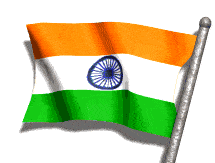

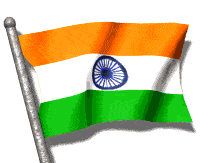


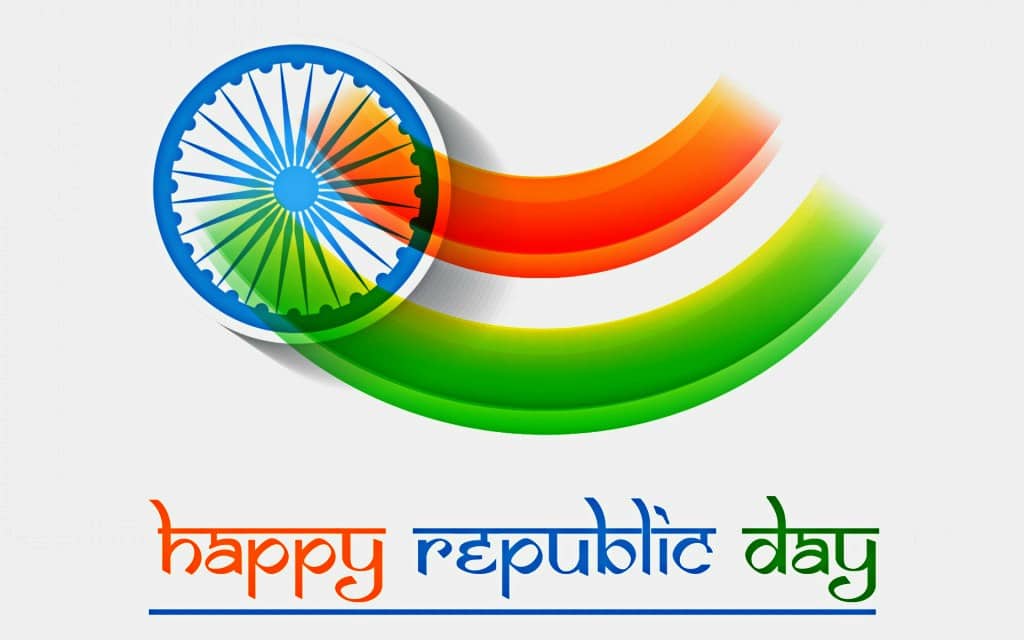
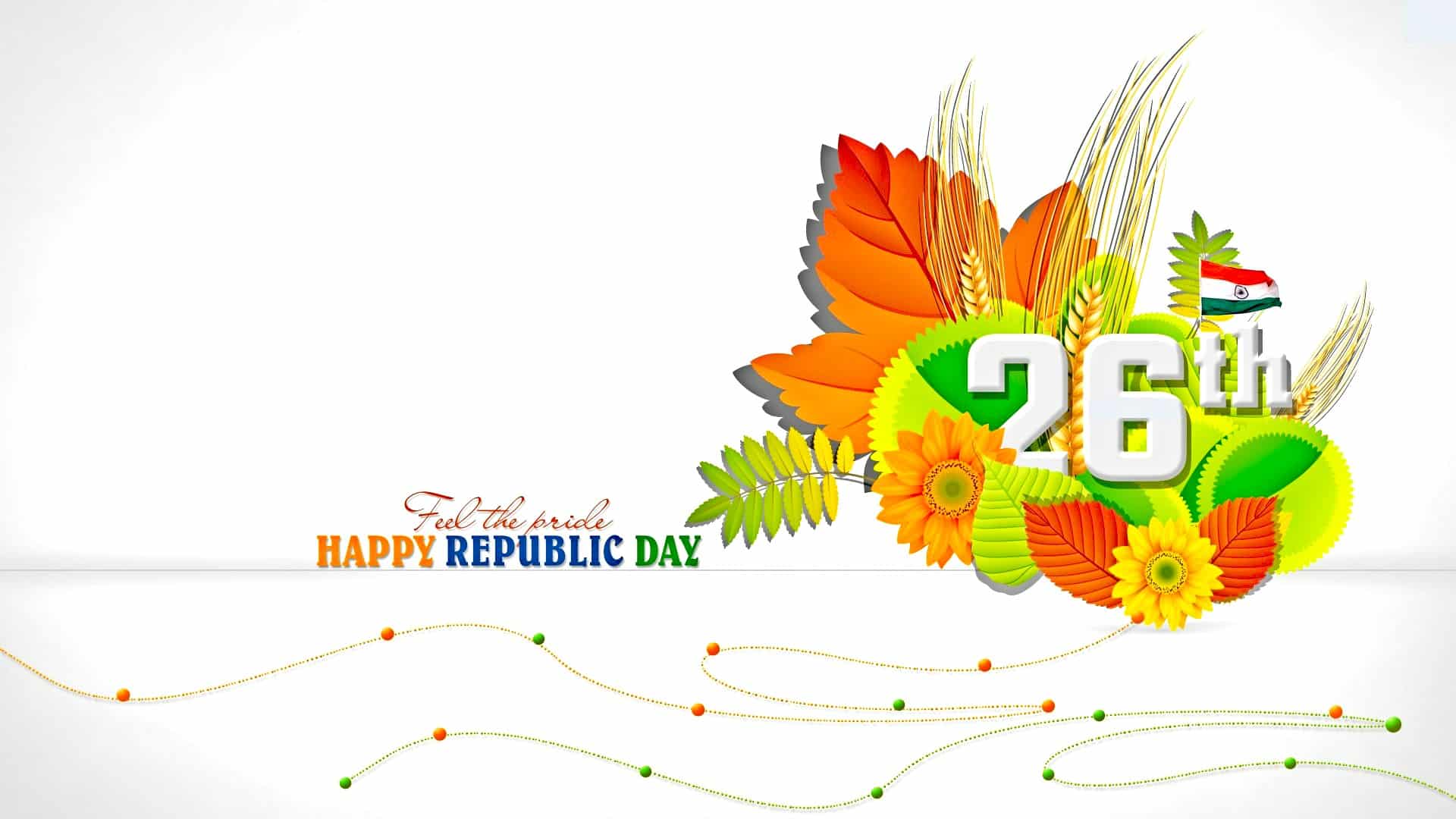
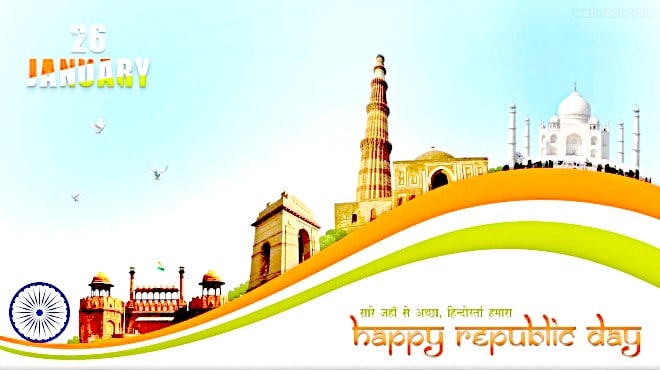



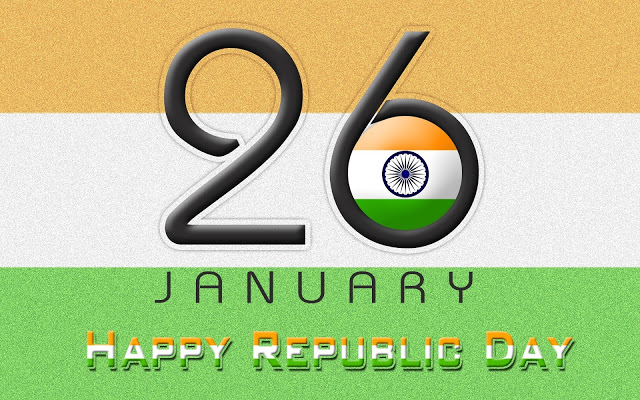
2511 Wed 24 Jan 2018 LESSON
23 Classical English
and related NEWS through http://sarvajan.ambedkar.org in
105
CLASSICAL LANGUAGE
Tipiṭaka Studies for University Students
https://www.dhamma.ru/sadhu/
https://www.dhamma.ru/sadhu/
Theravāda Buddhism Web Directory
Add Entry
Search
86 Classical Slovak
86 Klasický slovenský
Analytic Insight Net - bezplatná on-line Tipiṭaka Research and Practice Univerzita a súvisiace NEWS prostredníctvom http://sarvajan.ambedkar.org v 105 Klasické jazyky
Chanting & Songs
Sobhana.net - An Audio-Visual Library of Theravada Buddhism
Website: http://sobhana.net/audio/
Description:
- English Dhamma talks by well known teachers such as Bhikkhu Bodhi and
Ven. Narada Thera, Bhante Punnaji and Bhante Yogavacara Rahula;
- Sutta chants in Pali, the original language of the Buddha;
- Sinhala Dhamma talks by well known teachers such as Madihe Pannasiha Thera, Narada Thera, Gangodawila Soma Thera and others.
Chanting Guide
Website: http://www.accesstoinsight.
Description:
An online edition of “A Chanting Guide,” translated from Pali to
English by Phra Ajaan Thanissaro Bhikkhu, Abbot of Wat Metta, and
published by the Dhammayut Order in the United States of America.
Includes Pali passages with English translations for various types of
chants, including reflections and discourses.
See also: Lay Buddhist Practice
http://www.accesstoinsight.
Audio-Tipitaka
Website: http://www.audtip.org/
Description:
Sutta Readings in Pali, English and More.
Pali Chanting by the Wat Metta Sangha
Website: http://dhammatalks.org/chant_
Description:
Chants from “A Chanting Guide”, published by The Dhammayut Order in the United States of America.
Paritta Suttas Protection Discourses
Website: http://www.softerviews.org/
Description:
Parittas, with full Pali texts, recited by Mingun Sayadaw U
Vicittasara. You can also watch a YouTube video of the same discourses
recited by Sayadaw U Candasiri.
Chanting at Wat Pah Nanachat
Website: http://www.watpahnanachat.org/
Description:
A Night of Shining Prosperity
Chanting as a practice (Kevali Bhikkhu Oct 18 2010)
Dhammacakkappavattana Sutta
Dhammapahansa
Faith in the Tathagata
First and Last Words
Mindfulness of Breathing
Ovadapatimokkha
Secure Refuge
Sharing Merit
The Noble Eightfold Path
https://www.youtube.com/watch?
87 Classical Slovenian
87 Klasična slovenska
Analytic Insight Net - BREZPLAČNO Online Tipiṭaka Raziskave in prakse Univerze in sorodne NOVICE preko http://sarvajan.ambedkar.org v 105 KLASIČNIH JEZIKIH
https://www.youtube.com/watch…
The Voice of the Buddha
Benoy Behl
Published on Jul 22, 2014
Film about the International Tripitaka Chanting and other activities of the Light of Buddhadharma Foundation.
Category
Film & Animation
https://www.youtube.com/watch…
88 Classical Somali
88 Fasalka Soomaliyeed
Analytical Insight Net - Barta Internetka ee ‘Tipiṭaka Jaamacadda Cilmi-baarista iyo Tababarka’ iyo ‘NEWS’ iyada oo loo marayo http://sarvajan.ambedkar.org ee 105 LANGUAGE LANGUAGE
https://www.youtube.com/watch…
89 Classical Spanish
89 Español clásico
Analytic Insight Net - GRATIS en línea Tipiṭaka Research and Practice University y NOTICIAS relacionadas a través de http://sarvajan.ambedkar.org en 105 IDIOMAS CLÁSICOS
Dance and Meditation Courses + Performances Videos Excerpts of Director
Devi Dhyani- Energy Enhancement Meditation Courses; Free Reiki Mastery
using Secret Meditations decoded from Ancient Symbols
Analytic wawasan Net - FREE Online Tipiṭaka Panalungtikan sarta Universitas Praktek jeung warta patali ngaliwatan http://sarvajan.ambedkar.org dina 105 basa klasik
Angklung : Sundanese Culture Musical Instruments - West Java
Posted on Sunday, December 14, 2014
with
Angklung is a musical instrument played by means of bamboo which vibrated. The sound produced is the effect of the collision bamboo tubes that make up the instrument. These instruments are classified into types idiofon or instrument sound source music that comes from the base ingredients. Angklung is generally known from the area of West Java. Since November 2010, UNESCO named him as one of the world cultural heritage, with the category of Masterpiece of Oral and Intangible Heritage of Humanity.
etymology
The word comes from the angklung supposedly Sundanese (angkleung-angkleungan), which describes the motion of the body of the players Angklung swaying with the rhythm of the sound. However, there are also who believe the word is derived from Klung angklung, an imitation of the sound of the bamboo instrument. While one other theory states, the word “angklung” comes from the Balinese language, which is a number and lung. Figures mean tone, while the mean lung broken, or in other words, angklung meaningful tone incomplete.
Angklung History
According to Dr. Groneman, Angklung has been there in the land of the archipelago, even before the era of Hinduism. According to Jaap Kunst in his book Music in Java, other than in West Java, Angklung can also be found in South Sumatra and Kalimantan. Beyond that, the people of Lampung, East Java and Central Java are also familiar with the instrument.
In the Hindu era, the era of the Kingdom of Sunda, Angklung become an important instrument in various celebrations, especially with regard to the rites of planting, especially rice. In the neighborhood of the Kingdom of Sunda, recorded since the 7th century, Angklung played as a form of worship to Dewi Sri (the goddess of rice / goddess of fertility), that He bestows his blessing on plants and people’s lives. Not only as a medium of worship of the gods, in the days of the Kingdom of Sunda, Angklung is also a musical instrument played as morale boosters in the war, including the Bubat War, as told in the Song of Sunda.
Today, an instrument Angklung Angklung gubrag oldest preserved. Angklung is made in the 17th century in Jasinga, Bogor. Other ancient angklung can still track down there in Sri Baduga Museum, London. Meanwhile, the old tradition of Angklung that can be found in communities Baduy (Baduy), precisely in Lebak, Banten. To this day, they are still functioning as the angklung which inherited his ancestors, which accompany the rite planting.
In 1938, Daeng Soetigna, citizens of Bandung, create angklung with diatonic scales. Angklung Daeng Sutigna innovation is different from the angklung in general are based on scales trradisional pelog or salendro. Innovation is then made freely angklung can be played in harmony with Western musical instruments, and even can be presented in the form of an orchestra. Since then, more and reap Angklung popularity, until finally the United Nations, through UNESCO, on 18 November 2012, recognizing it as a world heritage that must be preserved. After Daeng Soetigna, one of his students, Udjo Ngalagena, continuing efforts to popularize Angklung Master findings, with the established “Saung Angklung“ in Bandung. To this day, the place came to be known as the “Saung Angklung Udjo“ is still a center of creativity with regard to Angklung
Types of Angklung
angklung Kanekes
Angklung Angklung Kanekes is played by the public Baduy (Baduy), in Banten. As mentioned earlier, Angklung traditions that exist in Baduy community is fairly ancient, and still preserved as exemplified function of their ancestors, which accompany the rite planting (rice). In Kanekes community, which is divided into two groups, ie groups Outer Baduy (Kajeroan) and group Baduy (Kaluaran Affairs), which is entitled to make Angklung just Jero Bedouin citizens, it was not everyone, but only those who become children of Angklung maker. Meanwhile, residents of Outer Baduy not make Angklung, but just bought it from Bedouin citizens Jero. The names of Angklung in Kanekes of the largest are: ovaries, ringkung, Dongdong, gossip, engklok, ovary leutik, torolok, and roel.
Angklung Dogdog Lojor
Art Dogdog Lojor contained in Kasepuhan Pancer Pangawinan communities, which inhabit about Mountain Mist, which borders the region of Jakarta, Bogor and Lebak. Lojor Dogdog term itself actually taken from the name of one of the instruments in this tradition, namely Dogdog Lojor. However, Angklung also get a portion that is no less important here, especially in the function of tradition, ie, as a companion planting rites. Having people there to Islam, in its development, the arts are also used to accompany circumcision and marriage. In Dogdog Lojor art, there are two instruments Dogdog Lojor and 4 large angklung instruments.
angklung Badeng
Badeng an Angklung art that uses as its main instrument. There Badeng Art Sanding Village, District Malangbong, Garut. Along with the development of Islam, Art Badeng also used for the purposes of propaganda and entertainment. However, it is believed in the art Badeng Angklung also have the same roots, namely as a companion planting rites. In Badeng arts, played 9 pieces Angklung, namely 2 roel angklung, angklung kecer 1, 4 Angklung Angklung ovary and father, 2 children angklung; 2 pieces dogdog, 2 fruit fly or Gembyung, and 1 manacle.
In addition to the three above Angklung arts tradition, many other areas in West Java which also inherited the tradition of Angklung, call it Angklung Beans (Priangan / Bandung), Angklung Badud (East Priangan / Kudat), and Angklung Bungko (Indramayu).
angklung Padaeng
Angklung Angklung Padaeng is now widely known, namely Angklung Daeng Soetigna results innovation, which uses diatonic scales. In line with the theory of music, specifically the Angklung Padaeng grouped into two, namely: Angklung Angklung melody and accompaniment. Angklung melody is specifically consists of two tubes with different voice tones one octave. In one unit of angklung, generally there are 31 small and 11 Angklung Angklung melody great melody. Meanwhile, Angklung Angklung accompaniment is used as a companion to play tones harmony. Voice tube consists of 3 to 4, according to the diatonic chord. After Daeng Soetigna innovation, other reforms to the angklung continues to grow. Some of them are: Angklung Sarinande, Arumba, Angklung Toel, and Angklung Sri Murni.
Angklung Playing Techniques
Plays an angklung is basically very simple, ie, one hand holding the frame angklung, and the other hand swing to produce sound. There are three basic techniques wiggle angklung, namely:
Kurulung (shakes), is the most common technique used, where one hand holding the frame angklung, and the other shaking the angklung for the desired tone, until the tubes one after clashing bamboo and produce sound.
Trowel (jerky), which is a technique in which the base tube is pulled quickly by the fingers into the palm of the right hand, so angklung will beep once (stacato).
Tengkep, ie similar techniques as kurulung, but one of the tubes being held not vibrating.
92) Classical Sundanese
2438 Jumatatu 12 Novemba 2017 Somo
Tipitaka
Tipitaka (Pali, “tatu,” + pitaka, “vikapu”),
au canon ya Pali, ni mkusanyiko wa maandiko ya lugha ya msingi ya Pali ambayo
fanya msingi wa mafundisho ya Buddha ya Theravada. Tipitaka na
maandishi ya Paracanonical Pali (maoni, historia, nk) pamoja ni mwili kamili wa maandiko ya Theravada.
Ya
Pali Canon ni mwili mkubwa wa vitabu: tafsiri ya Kiingereza the
maandiko huongeza hadi maelfu ya kurasa zilizochapishwa. Wengi (lakini si wote) wa
Canon tayari imechapishwa kwa Kiingereza zaidi ya miaka. Ingawa
sehemu ndogo ndogo ya maandiko haya inapatikana kwenye tovuti hii, hii
ukusanyaji unaweza kuwa mahali pazuri kuanza.
Migawanyiko matatu ya Tipitaka ni:
Vinaya Pitaka
Mkusanyiko wa maandiko kuhusu sheria za maadili zinazosimamia
mambo ya kila siku ndani ya Sangha - jumuiya ya bhikkhus (watawala
waliowekwa rasmi) na bhikkhunis (waliowekwa
wasomi). Mbali zaidi ya orodha tu ya sheria, Vinaya Pitaka pia
inajumuisha hadithi nyuma ya asili ya kila utawala, kutoa
maelezo ya kina ya ufumbuzi wa Buddha kwa swali la jinsi ya
kudumisha umoja wa jumuiya ndani ya kiroho kubwa na tofauti
jumuiya.
Sutta Pitaka
Ya
ukusanyaji wa sutta, au mazungumzo, yaliyotokana na Buddha na wachache
wa wanafunzi wake wa karibu, yaliyo na mafundisho yote ya kati ya
Buddha ya Theravada. (Tafsiri zaidi ya elfu moja ya sutta ni
inapatikana kwenye tovuti hii.) Suttas imegawanywa kati ya nikayas tano (makusanyo):
Digha Nikaya - “mkusanyiko mrefu”
Majjhima Nikaya - “ukusanyaji wa urefu wa katikati”
Samyutta Nikaya - “ukusanyaji wa makundi”
Anguttara Nikaya - “mkusanyiko wa zaidi”
Khuddaka Nikaya - “ukusanyaji wa maandiko madogo”:
Khuddakapatha
Dhammapada
Udana
Itivuttaka
Sutta Nipata
Vimanavatthu
Petavatthu
Theragatha
Therigatha
Jataka
Niddesa
Patisambhidamagga
Apadana
Buddhavamsa
Cariyapitaka
Nettippakarana (ni pamoja na tu katika toleo la Kiburma la Tipitaka)
Petakopadesa (””)
Milindapañha (””)
Abhidhamma Pitaka
Ya
ukusanyaji wa maandiko ambayo misingi ya mafundisho ya msingi
iliyotolewa katika Pitta ya Sutta inafanywa upya na kuandaliwa upya katika
mfumo wa utaratibu ambao unaweza kutumika kwa uchunguzi katika
asili ya akili na suala.
https://www.youtube.com/watch…
Sai Htee Saing - စဥ္းစားပါဦး (Sinn Sarr Par Own)
2,021,857 views
91 Classical Swahili
Uchambuzi Insight Net - FREE Online Tipiṭaka Utafiti na Mazoezi Chuo Kikuu na NEWS kuhusiana na http://sarvajan.ambedkar.org katika 105 LANGUAGES CLASSICAL
Yukon Sai
Published on Sep 1, 2010
The song is from the Unplugged Live of U Sai Htee Saing. Title
“စဥ္းစားပါဦး (Sinn Sarr Par Own)” means “Pls,, Think”. The Lyrics is so
cool ~~~
Category
Music
23 Classical English
and related NEWS through http://sarvajan.ambedkar.org in 105
CLASSICAL LANGUAGE
Tipiṭaka Studies for University Students
92 Classical Swedish-klassisk svenska,93 Classical Tajik-тоҷикӣ классикӣ,94 Classical Tamil-செம்மொழி தமிழ்,94 Classical Telugu-క్లాసికల్ తెలుగు
https://www.youtube.com/watch…
92 Classical Swedish
92 klassisk svenska
Analytisk Insight Net - GRATIS Online Tipiṭaka Research and Practice University och relaterade NYHETER via http://sarvajan.ambedkar.org i 105 klassiska språk
https://www.youtube.com/watch…
93 Classical Tajik
93 тоҷикӣ классикӣ
Аналитик Insight Net - Бюллетенҳои онлайн дар сомонаҳои тадқиқотӣ ва таҷрибаомӯзӣ ва NEWS аз тариқи http://sarvajan.ambedkar.org дар 105 лингвистикӣ классикӣ
(Tajik Music) Jurabek Murodov | Munojot
18,933 views
xorasun
Published on Jun 28, 2009
One of the most popular tenors of Tajik classical music - Shashmaqom -
Jurabek Murodov brings you this song for your enjoyable listening.
Jurabek Murodov was born in 1942 in Tajikistan. He earned a
highly-esteemed title of the People’s Artist of the USSR in 1979.
She’r az Tughral. Enjoy the song!
Category
Music
https://www.youtube.com/watch…
Divine Chants of Buddha By Hariharan
http://www.tipitaka.org/taml/
Tipiṭaka (Tamil)
திபிடக (மூல)
அட்ட²கதா²
டீகா
அன்ய
Bhajan: Buddham Sharanam Gachchami I The Three Jewels Of Buddhism
Album Name: Buddham Sharanam Gachchami
Singer: Hariharan
Music Director: Shailendra Bhartti
Lyrics: Traditional
Voice: O.P. Rathore
Music Label: T-Series
Subscribe: http://www.youtube.com/
Bhakti Sagar: http://www.facebook.com/
To set popular Bhakti Dhun as your HelloTune, Airtel subscribers Dial 57878881 (toll free)
For Spiritual Voice Alerts, Airtel subscribers Dial 589991 (toll free)
https://www.galatta.com/…/
Ancient Buddha Chants
94 Classical Tamil
94 செம்மொழி தமிழ்
பகுப்பாய்வு இன்சைட் நிகர - இலவச ஆன்லைன் Tipiṭaka ஆராய்ச்சி மற்றும் பயிற்சி பல்கலைக்கழகம் மற்றும் தொடர்புடைய செய்திகள் மூலம் http://sarvajan.ambedkar.org 105 கிளாசிக் மொழிகளில்
# Tracks Singers Length Likes
1
Biddham Saranam Gacchami
2.35
2
Buddhavandana
26.52
3
Dhammam Saranam Gacchami
2.83
4
Dhammapada
2.58
5
Dhammavandana
0.88
6
Namo Tassa Bhagavato
0.88
7
Pancha Sheelang
1.37
8
Sangaham Saranam Gachaami
0.80
9
Sanghavandana
1.38
10
Vandana
19.08
https://www.youtube.com/watch…
http://www.tipitaka.org/telu/
94 Classical Telugu
94 క్లాసికల్ తెలుగు
విశ్లేషణాత్మక
ఇన్సైట్ నెట్ - ఉచిత ఆన్లైన్ Tipiṭaka రీసెర్చ్ అండ్ ప్రాక్టీస్
విశ్వవిద్యాలయం మరియు సంబంధిత న్యూస్ ద్వారా http://sarvajan.ambedkar.org
105 CLASSICAL LANGUAGES
Tipiṭaka (Telugu)
తిపిటక (మూల)
అట్ఠకథా
టీకా
అన్య
Meditation Buddhist Chants - Indian Version
71,459 views
Anakaric Dharma
Published on Jun 9, 2012
Words have the power to both destroy and heal. When words are both true and kind, they can change our world.
By Buddha
Category
Music
23 Classical English
and related NEWS through http://sarvajan.ambedkar.org in
105
CLASSICAL LANGUAGE
Tipiṭaka Studies for University Students
92 Classical Swedish-klassisk svenska,93 Classical Tajik-тоҷикӣ классикӣ,94 Classical Tamil-செம்மொழி தமிழ்,94 Classical Telugu-క్లాసికల్ తెలుగు
https://www.youtube.com/watch…
92 Classical Swedish
92 klassisk svenska
Analytisk Insight Net - GRATIS Online Tipiṭaka Research and Practice University och relaterade NYHETER via http://sarvajan.ambedkar.org i 105 klassiska språk
https://www.youtube.com/watch…
93 Classical Tajik
93 тоҷикӣ классикӣ
Аналитик Insight Net - Бюллетенҳои онлайн дар сомонаҳои тадқиқотӣ ва таҷрибаомӯзӣ ва NEWS аз тариқи http://sarvajan.ambedkar.org дар 105 лингвистикӣ классикӣ
(Tajik Music) Jurabek Murodov | Munojot
18,933 views
xorasun
Published on Jun 28, 2009
One of the most popular tenors of Tajik classical music - Shashmaqom -
Jurabek Murodov brings you this song for your enjoyable listening.
Jurabek Murodov was born in 1942 in Tajikistan. He earned a
highly-esteemed title of the People’s Artist of the USSR in 1979.
She’r az Tughral. Enjoy the song!
Category
Music
https://www.youtube.com/watch…
Divine Chants of Buddha By Hariharan
http://www.tipitaka.org/taml/
Tipiṭaka (Tamil)
திபிடக (மூல)
அட்ட²கதா²
டீகா
அன்ய
Bhajan: Buddham Sharanam Gachchami I The Three Jewels Of Buddhism
Album Name: Buddham Sharanam Gachchami
Singer: Hariharan
Music Director: Shailendra Bhartti
Lyrics: Traditional
Voice: O.P. Rathore
Music Label: T-Series
Subscribe: http://www.youtube.com/
Bhakti Sagar: http://www.facebook.com/
To set popular Bhakti Dhun as your HelloTune, Airtel subscribers Dial 57878881 (toll free)
For Spiritual Voice Alerts, Airtel subscribers Dial 589991 (toll free)
https://www.galatta.com/…/
Ancient Buddha Chants
94 Classical Tamil
94 செம்மொழி தமிழ்
பகுப்பாய்வு இன்சைட் நிகர - இலவச ஆன்லைன் Tipiṭaka ஆராய்ச்சி மற்றும் பயிற்சி பல்கலைக்கழகம் மற்றும் தொடர்புடைய செய்திகள் மூலம் http://sarvajan.ambedkar.org 105 கிளாசிக் மொழிகளில்
# Tracks Singers Length Likes
1
Biddham Saranam Gacchami
2.35
2
Buddhavandana
26.52
3
Dhammam Saranam Gacchami
2.83
4
Dhammapada
2.58
5
Dhammavandana
0.88
6
Namo Tassa Bhagavato
0.88
7
Pancha Sheelang
1.37
8
Sangaham Saranam Gachaami
0.80
9
Sanghavandana
1.38
10
Vandana
19.08
https://www.youtube.com/watch…
http://www.tipitaka.org/telu/
94 Classical Telugu
94 క్లాసికల్ తెలుగు
విశ్లేషణాత్మక
ఇన్సైట్ నెట్ - ఉచిత ఆన్లైన్ Tipiṭaka రీసెర్చ్ అండ్ ప్రాక్టీస్
విశ్వవిద్యాలయం మరియు సంబంధిత న్యూస్ ద్వారా http://sarvajan.ambedkar.org
105 CLASSICAL LANGUAGES
Tipiṭaka (Telugu)
తిపిటక (మూల)
అట్ఠకథా
టీకా
అన్య
Meditation Buddhist Chants - Indian Version
71,459 views
Anakaric Dharma
Published on Jun 9, 2012
Words have the power to both destroy and heal. When words are both true and kind, they can change our world.
By Buddha
Category
Music
2511 Wed 24 Jan 2018 LESSON
23 Classical English
and related NEWS through http://sarvajan.ambedkar.org in
105
CLASSICAL LANGUAGE
Tipiṭaka Studies for University Students
https://www.youtube.com/watch…
เพลงพระคาถาชินบัญชร(
289,695 views
Ray T
Published on Aug 14, 2010
Category
Music
Pali in Thai Script
95 Classical Thai
95 คนไทยคลาสสิก
Analytic Insight Net - ฟรีออนไลน์Tipiṭakaวิจั
https://www.youtube.com/watch…
96 Classical Turkish
96 Klasik Türk
Analytic Insight Net - ÜCRETSİZ Çevrimiçi Tipiṭaka Araştırma ve Uygulama Üniversitesi ve 105 ile ilgili http://sarvajan.ambedkar.org aracılığıyla HABERLER KLASİK DİLLER
Pure Turkish Classical Ottoman Music: 19 th Century - Ada Ciftetelli
17,390 views
https://www.youtube.com/watch…
Medley of Ukrainian Folk Songs
97 Classical Ukrainian
97 класичний український
Аналітичний Insight Net - БЕЗКОШТОВНИЙ Онлайн Науково-практичний університет Типітака та пов’язані новини через http://sarvajan.ambedkar.org в 105 класичних мовах.
https://www.youtube.com/watch…
Ukrainian Folk Song - Marichka
George Stone
Published on Jun 22, 2011
My parents instilled the love of Ukrainian culture in me while I was
growing up in NYC. I’ve never been to Ukraine but some day I hope to go.
parents instilled the love of Ukrainian culture in me while I was
growing up in NYC. I’ve never been to Ukraine but some day I…
https://www.youtube.com/watch…
98 Classical Urdu
98 کلاسیکی اردو
تجزیاتی انٹرویو نیٹ - مفت آن لائن ٹپتاٹاکا ریسرچ اینڈ پریکٹس یونیورسٹی اور متعلقہ خبریں 105 کلاسیکی زبانوں میں http://sarvajan.ambedkar.org کے ذریعے
https://quizlet.com/24…/intro-
Intro. to World Music 3.1
99 Classical Uzbek
99 Klassik o’zbek
Analitik tushuncha aniq - bepul onlayn tipiṭaka Tadqiqot va amaliyot universiteti va http://sarvajan.ambedkar.org orqali 105 ta klassik tilda
Maghrib
Literally, “the time or place of the sunset.” The Arabic name
designating the region from present-day Libya west through Morocco.
Mashriq
Literally, “the time or place of the sunrise.” The Arabic name
designating the parts of Asia (and Egypt) conquered and populated by the
Arabs.
Arabic
A Semitic language originating with the Arab
ethnic group; also, the holy language of Islam, and a musical tradition
whose history is intricately linked with the spread of the language.
Ottoman Empire
A powerful Turkish dynasty that ruled over various parts of West Asia,
Eastern Europe, and Northern Africa from the thirteenth to the early
twentieth century.
Takht
An Arabic music ensemble including
zithers, bowed and plucked lutes, drums, aerophones, and sometimes
non-traditional instruments.
Kanun
(also, qanun) A plucked zither used in Turkish and Arabic music traditions, prominent in takht ensembles.
Raqs Sharqi
The Arabic name for what is commonly referred to by outsiders as “belly dance.”
Tarab
Arabic word for a state of emotional transformation or ecstasy achieved through music.
Dhikr
(also, Zikr) A Sufi ritual in which believers chant the name of God with the goal of entering an ecstasy state.
Jalal Al-Din Muhammad Rumi
Sufi saint of Islamic mysticism known for his poems and as the founder of the Mevlevi religious order.
Adhan
The islamic call to prayer.
Shiah
The minority branch of Islam.
Muhammad
Muslim prophet and Arab leader who during his lifetime (571 A.D. - 632
A.D.) spread the religion of Islam and unified a great deal of the
Arabian Peninsula.
Sunni
The mainstream or majority branch of Islam.
Sufi
The mystical branch of Islam.
UD
(Also, Al ‘Ud) A fretless, plucked pear-shaped lute that is found in
Arabic music traditions and is the origin of certain lutes of Africa,
Asia, and Europe.
Maquam
(Also, Makam) Arabic/Turkish mode or system of rules and expectations for composition and improvisation.
Santur
A hammered zither from the Persian classical tradition.
Dastgah
Persian mode or system of rules and expectations for composition and improvisation.
Dynasty
In china, a ruling family, like the Ming, and the era characterized by that family’s dominance.
Overtone
One of the ascending group of tones that form the harmonic series derived from the fundamental pitch.
Khoomei
Throat or overtone singing from Mongolia.
Dung Chen
A long metal trumpet with low tones blown during Tibetan ritual.
Munojaat Yulicheeva
leading performer of classical Uzbek music, always accompanied by her master Shawqat Mizaev, famous rubab player
Sarakhbori Dugox
national eastern dance that Munojaat performs
Sevara Nazarkhan
Uzbek singer, songwriter, and musician of pop music
Hector Zazou
Real World Records - was a prolific French composer and record producer
who worked with, produced, and collaborated with an international array
of recording artists.
Yol Bolsin
pop song by Sevara Nazarkhan (Uzbek singer)
Ashot Petrosiants
lead acoustician in folk orchestra, founded the conservatory
Doyra
Membranophone, A medium sized frame drum with jingles (Uzbekistan / Central Asia)
Dutor
Chordophone, long necked, two stringed lute. (Uzbekistan / Central Asia)
Kashgar Rubob
chordophone from uzbekistan
Gijak
chordophone from uzbekistan
Arranged Folklore
The practice of collecting tunes from rural communities, codifying, and
harmonizing them for polyphonic performance by large ensembles.
Estrada
popular music in Uzbekistan, combo of national instruments and synthesized sounds
Usul
name for all rhythmic modes/patterns in Turkish classical music
Gardun
8 Beats common in uzbek music
Mog’ulchai
One of the main personalities in the Book of Esther in the Hebrew Bible. He was the son of Jair, of the tribe of Benjami
Sarahbor
…
Nola
Pitch-bending ornaments on on voice or instruments that are often micro
tonal (in between notes) and are considered highly expressive
Ouge
the climatic point in a piece of classical uzbek / tajik music like the shashmaqom
Shashmaqom
a set of repertoire of uzbek / tajik classical music that originated in
the city of bukhara, traditionally played heterphonically, both
instrumental and vocal
Sufi
a Muslim who represents the mystical dimension of Islam
Gusheh
Secondary melodies associated with a dastgah
Each dastgah can have many gushehs (collection of short memories)
Firqa
large orchestral ensembles consisting of traditional Arabia instruments found in the middle east
Ney
Flute instrument, performed slightly off to the right, not directly in
front of player, breathy or pure sound (middle eastern flute)
Buzuq
long necked lute of the takht ensemble, with 24 movable frets. (chordophone from Turkey)
Musiqa/non-musiqa
In Islamic theory, expressions that combine pitch and rhythm are
divided into a higher-level category called non-musiqa, and a
lower-level category called Musiqa. Non-musiqa is considered legitimate
and includes readings from the Qu’ran. Musiqa includes familial,
celebratory, occupational, and military band music, and is discouraged
by fundamentalist Muslims.
Layali
a vocal improvisational form in Arabic music traditions
Taqasim
in Arabic classical music, instrumental improvisations that may either
be extended items in a recital or short introductions to, or bridges
between, composed pieces
Masnavi
an extensive poem written in
persian by Jalal al-Din Muhammad rumi. Spiritual writing that teaches
Sufis how to reach their goal of being in union w/ God
Umm Kulthum
1950s-70s
Very popular pop singer when Egypt was emerging towards independence
Voice of the people
Musical training started at school reciting the Koran
Gave radio concerts on Sunday nights and the whole country shut down to listen to her sing
Gamal Abdel Nasser
Arab leader, set out to modernize Egypt and end western domination,
nationalized the Suez canal, led two wars against the Zionist state,
remained a symbol of independence and pride, returned to socialism,
nationalized banks and businesses, limited economic policies
Chinggis Khan
born in 1170s in decades following death of Kabul Khan; elected khagan
of all MOngol tribes in 1206; responsible for conquest of northern
kingdoms of China, territories as far west as the Abbasid regions; died
in 1227 prior to conquest of most of the Islamic world
Urtyn duu
a monglian love song, long songs…associated with formal celebrations and rituals…free expansive rhythms
Morin huur
fiddle, large bowed instrument of the lute type (Chordophone from Mongolia)
Dalai Lama
chief lama and once ruler of Tibet (universal priest)
Yunchen Lhamo
most acclaimed Tibetan singer-songwriter living in NYV in exile
Incantation and Mani
Ritual recitation of verbal charms or spells to produce a magic effect
Om mani padme hum
Buddhist Mantra that invokes the powerful benevolent attention and blessings of Chenrezig, the embodiment of compassion.
Kang dung
aerophone from tibet (trumpet)
Dung kar
aerophone from tibet (conch shell trumpet)
Rom/rol mo
an ethnic group originating in India characterized by a semi-nomadic lifestyle; known as gypsies
gyaling
a double reed aerophone traditional to Tibet. It is used specifically in Tibetan monasteries during chanting and prayer
Drilbu
idiophone from tibet (Bell)
On ikki maqom
A muqam is the melody type used in Uyghur music, that is, a musical
mode and set of melodic formulas used to guide improvisation and
composition.
The muqam system developed among the Uyghur in
northwest China and Central Asia over approximately the last 1500 years
from the Arabic maqam modal system that has led to many musical genres
among peoples of Eurasia and North Africa
Rawap
stringed
instrument (chordophone) 5 stringed instrument. A mobile instrument,
taken by farmers, part of the nomadic tradition. Has 3 main parts and is
played as part of everyday life, very cherished by the Uyghurs.
Cultural Revolution
Campaign in China ordered by Mao Zedong to purge the Communist Party of
his opponents and instill revolutionary values in the younger
generation.(p. 848)
Bayin
Chinese organological system based on 8 materials
Sizhu
Chinese music(silk and bamboo) of the Jiangnan region, featuring erhu,
pipa, gu/zheng. Played in tea shops (silk and bamboo ensembles)
Jiangnan Sizhu
Chinese chamber instrumental ensemble made up of strings and winds
popular around the areas of Shanghai. Played by amateurs for their own
enjoyment. Like other traditional Chinese music it is considered a kind
of background music to enhance the ambiance of a pleasant social
environment.
Qin
(Guqin), A people and state in the Wei Valley
of eastern China that conquered rival states and created the first
Chinese empire (221-206 B.C.E.). The Qin ruler, Shi Huangdi,
standardized many features of Chinese society and enslaved subjects.
(163)
Tablature
a notational system (written for lute) that
tells the player which strings to pluck and where to place the fingers
on the strings, rather than indicating what pitches will result.
Jianpu
(cipher notation) a musical notation system widely used among the Chinese people
Jingju
Beijing Opera
Yangbanxi
(model revolutionary opera), translates to “model revolutionary opera”.
The Chinese term for Opera infused with Communist and Nationalist
political messages during the Cultural Revolution (1966-1976) (there
were only 8 model operas)
P’ansori
one man opera story telling
Samul-nori
genre of traditional percussion music originating in Korea
Sheng/Dan/Jing/Chou
Sheng — Male Role; Dan — Female Role; Jing — Painted Face Male; Chou — The Comedy Role.
Erhu
Bowed, two-string fiddle from China, with its bow hairs fixed between the strings; rests on the leg while playing.
Yangqin
A Chinese hammered dulcimer with a trapezoidal sound box and metal strings that are struck with bamboo sticks.
Pipa
Pear-shaped, plucked chordophone with four strings. Chinese instrument
of Central Asian heritage; close historical association with the zheng.
Sheng
the male role of the Xiqu theatre, where companies would be composed of
all men. The old men were called the lao sheng, the young men were
called the xiao sheng, and the warrior was called wu sheng.
Jinghu
lead instrument in beijing opera, a fiddle pitched an octave higher than the erhu, high fiddle
Suona
Traditional Chinese instrument with a double reed, similar to the Western oboe.
Dizi
transverse bamboo flute
Buk
membranophone from korea
Sarod
North indian (Hindustani) string instrument that is plucked with a plectrum of ivory or coconut shell
Sitar
a stringed instrument of India
Tabla
a set of two drums
Tanpura
A long-necked plucked lute (a stringed instrument found in different
forms and in many places). The body shape of the tambura somewhat
resembles that of the sitar, but it has no frets - only the open strings
are played to accompany other musicians. It has four or five (rarely
six) wire strings, which are plucked one after another in a regular
pattern to create a harmonic resonance on the basic note (bourdon or
drone function).
Harmonium
a free-reed instrument in which air is forced through the reeds by bellows
Veena
fretted string. played by Saraswati (Indian goddess of music/learning)
Sruti box
A drone instrument comprised of a small wooden box with tuned reeds (like a reed organ), with air provided by a hand bellows.
Mrindangam
Membranophone, Barrel-shaped drum (South India)
Tavil
double headed cylindrical drum
Ghatam
A large clay pot played with fingers and hands.
Kriti
a genre of devotional hindu poetry from south India
Gamakam
An ornamentation that is used in the performance of Indian classical
music. The unique character of each raga is given by its gamakas, making
their role essential rather than decorative in Indian music. Translates
to ‘ornamented note’
Guru
a Hindu or Buddhist religious leader and spiritual teacher
Tyagaraja
South Indian who gave legitimacy to south indian musicians.
Syama Sastri
is among the most renowned composers of Carnatic music
Hindustani
a form of Hindi spoken around Delhi
Carnatic
“Classical” music of southern India, dates back to palaces of rajas and
maharajas, but took shape during late eighteenth and early nineteenth
centuries
Filmi
(Filmi Git), popular music taken from films in india
Lata Mangeshkar
famous filmi singer from india
Raga
In Indian classical music, a complete and self-contained melodic system
that serves as the basis for all the melodic materials in any
composition or performance created in that raga.
Mode
how something is done or how it happens
Tala
Metric cycle in Indian music. Begins and ends on same (1st and last).
Certain number of beats (matras). Organized in vibhags (larger units,
groups). Vibhags demonstrated with claps (strongest) waves and finger
counts.
Bols
mnemonic syllables corresponding to drum strokes in indian drumming traditions
Tintal
A 16-beat metric cycle (i.e., tala) used in Hindustani raga and other types of North Indian music.
Solfege
a voice exercise
Sargam
the syllables of the seven notes of Indian music- Sa re ga ma pa dha ni
Alap
can refer to the entire opening of a North Indian classical piece; consists of alap, jor, and jhela
Jhala
refers to a set of drone strings on indian chordophones
Gat
The main part of a Hindustani raga performance following the alap; a
tala (metric cycle) serves as its metric/rhythmic foundation; the entry
of a rhythmic accompaniment part (usually played on tabla) marks the
commencement of the gat.
Aashish Khan
Indian classical musician, known for his virtuosity on the Sarode. Also a professor of Indian classical music at UCSC
Rasa
“Flavor,” or powerful feeling, essence or individuality to which the
audience must surrender themselves during Indian dramatics.There are
eight in a drama: erotic, comic, compassionate, furious, heroic,
terrifying, disgusting and awesome.
Bhajan
A particular class of Hindu devotional songs and hymns with close ties to the historical development of Indian classical music.
Muezzin
The muslim official of a mosque who summons the faithful to prayer from a minaret five times a day.
Tahrir
An ornament used by vocalists; specifically a thrill or rapid
oscillation between a different vocal register; fluttering of the voice.
Tar
Guitar-shaped instrument, heavy -sounding, not much rhythm, flash flourishes of notes; fast repetition.
Zarb/Tombak
Membranophone; goblet-shaped drum.
indigenization
The creative recombination and transformation of local cultural features with features from elsewhere.
aradhana
Annual Hindu festival observed in many parts of the world; means connecting with the universal self.
Bollywood
Indian version of Hollywood; centered in Mumbai (Bombay)
Ravi Shankar
Indian sitar player who popularized classical indian music in the west. 1920.
Mantra
The repetition of mystic incantations in Hinduism and Buddhism.
Tanbur
Chordophone; Plucked Turkish lute.
Gongche Notation
Common notation for instruments other than qin. Pitch
syllables/characters; read from top to down, right to left; no rhythmic
indication.
Amateur vs Pro. Musicians
…
Civil vs Military Sections
Civilian - soft, quiet instruments; military - louder instruments
Pungmul
Korean folk music tradition that includes drumming, dancing, and
singing. Most performances are outside, with tons of players, all in
constant motion.
nongak
Associated with Agraran rites; prayers for a bountiful harvest; involves drums, gongs, and an hour glass drum.
Turgun Alimatov
Uzbek musician who learned music from father and never took a formal
music lesson; strongly identified with sentiments of Uzbek nationalism.
terms · Maghrib → Literally, “the time or place…, Mashriq → Literally,
“the time or place…, Arabic → A Semitic language originating…, Ottoman
Empire → A powerful Turkish dynasty tha…, Takht → An Arabic music
ensemble inclu…















